We walked along the grand avenue of ram-headed sphinxes and entered the magnificent Hypostyle Hall, where massive sandstone columns towered above us, each one carved with detailed hieroglyphs. The obelisks of Tuthmosis I and Hatshepsut stand tall, and the pylons are decorated with intricate reliefs that seem to come alive in the soft afternoon light.
But what really made our visit unforgettable was the Light and Sound Show at night. Sitting under the stars as the temple lit up in a dramatic interplay of lights, storytelling, and music was pure magic. It added a whole new layer of emotion to the site, an experience we’ll never forget.
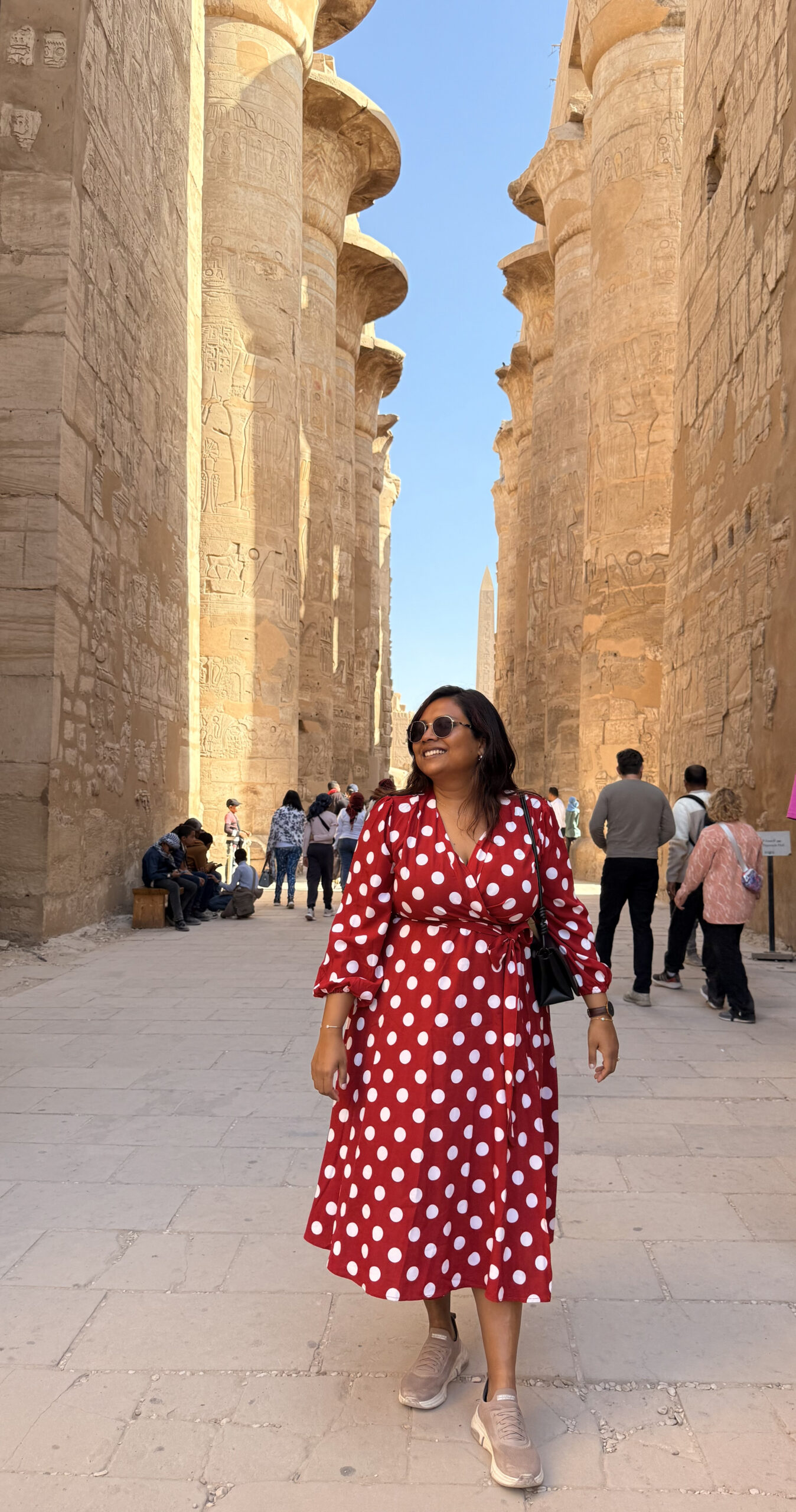
12. Walk around the gorgeous Luxor Temple
Exploring Luxor Temple was one of the most memorable moments of our trip. What makes it unique is its location, right in the middle of the city, with everyday life buzzing around it. Built by Amenhotep III and later expanded by Tutankhamun, Horemheb, and Ramses II, the temple is a stunning example of ancient Egyptian architecture and symbolism.
As we walked through the grand entrance lined with towering statues of Ramses II and down the avenue of sphinxes that once connected it to Karnak, our guide shared a fun and fascinating detail. Luxor Temple and Karnak are both located on the east bank of the Nile—the side that represents life and rebirth, as it’s where the sun rises. In contrast, the Valley of the Kings and Queens lies on the west bank, symbolising death and the afterlife, where the sun sets. That alignment made the experience even more meaningful.
We visited around sunset, and the way the fading light illuminated the temple’s columns and carvings was absolutely magical. Luxor Temple may not be as massive as Karnak, but it carries a powerful energy and a sense of timeless beauty that’s hard to forget.
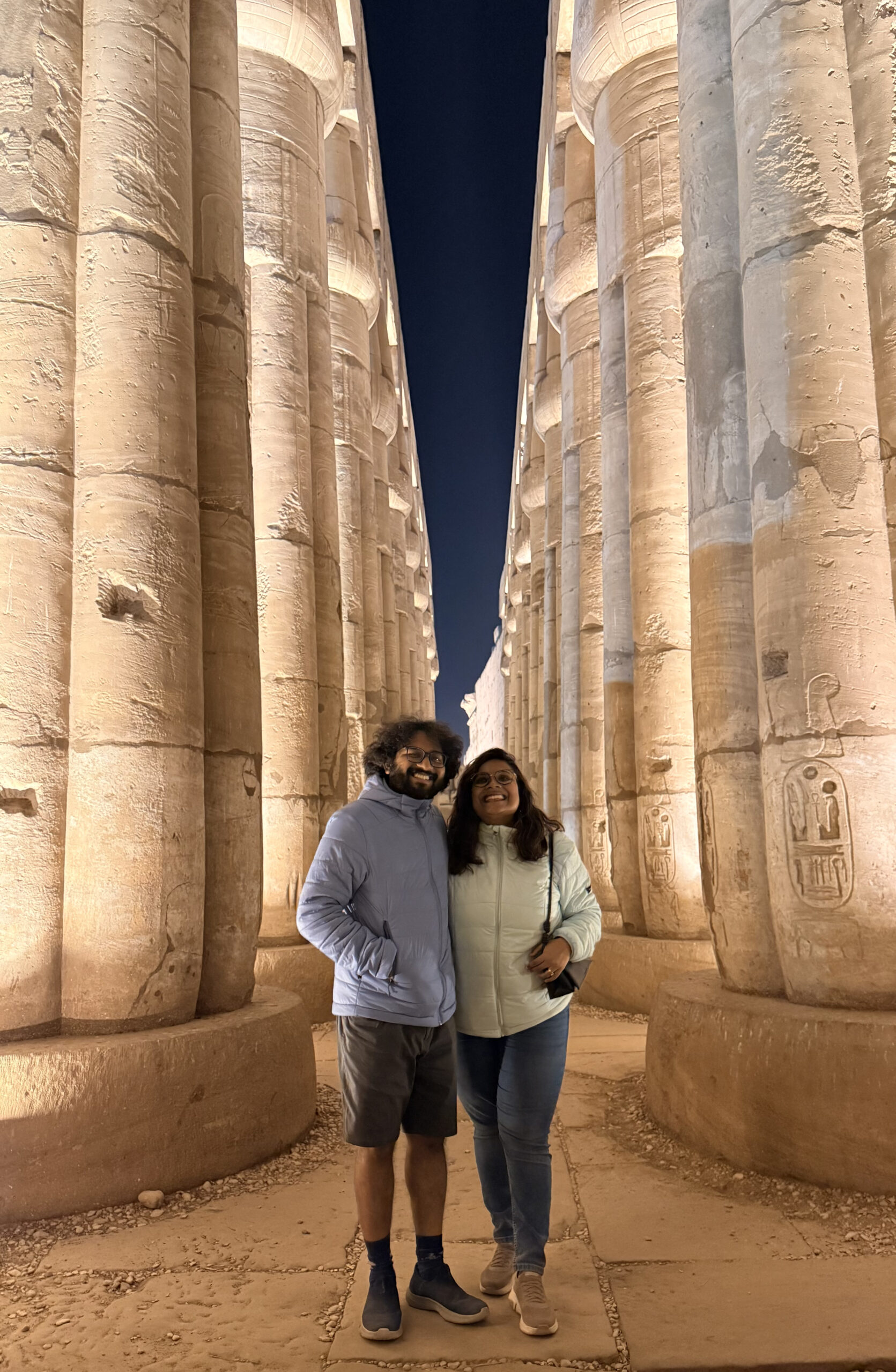
13. Take a sunset felucca ride on the Nile in Luxor
One of the best things to do in Egypt is to sit on a felucca and watch the sunset.
As the boat glided gently, I watched the city of Luxor and the silhouette of distant minarets, and the sun began to dip behind the Theban hills. The entire landscape turned golden, then orange, then soft pink. There was no engine noise, just the sound of water lapping against the hull and the occasional creak of the sail in the wind.
For us, the sunset felucca ride on the Nile was even more special because we met Yusuf there, a man who showered us with love and touched our hearts.
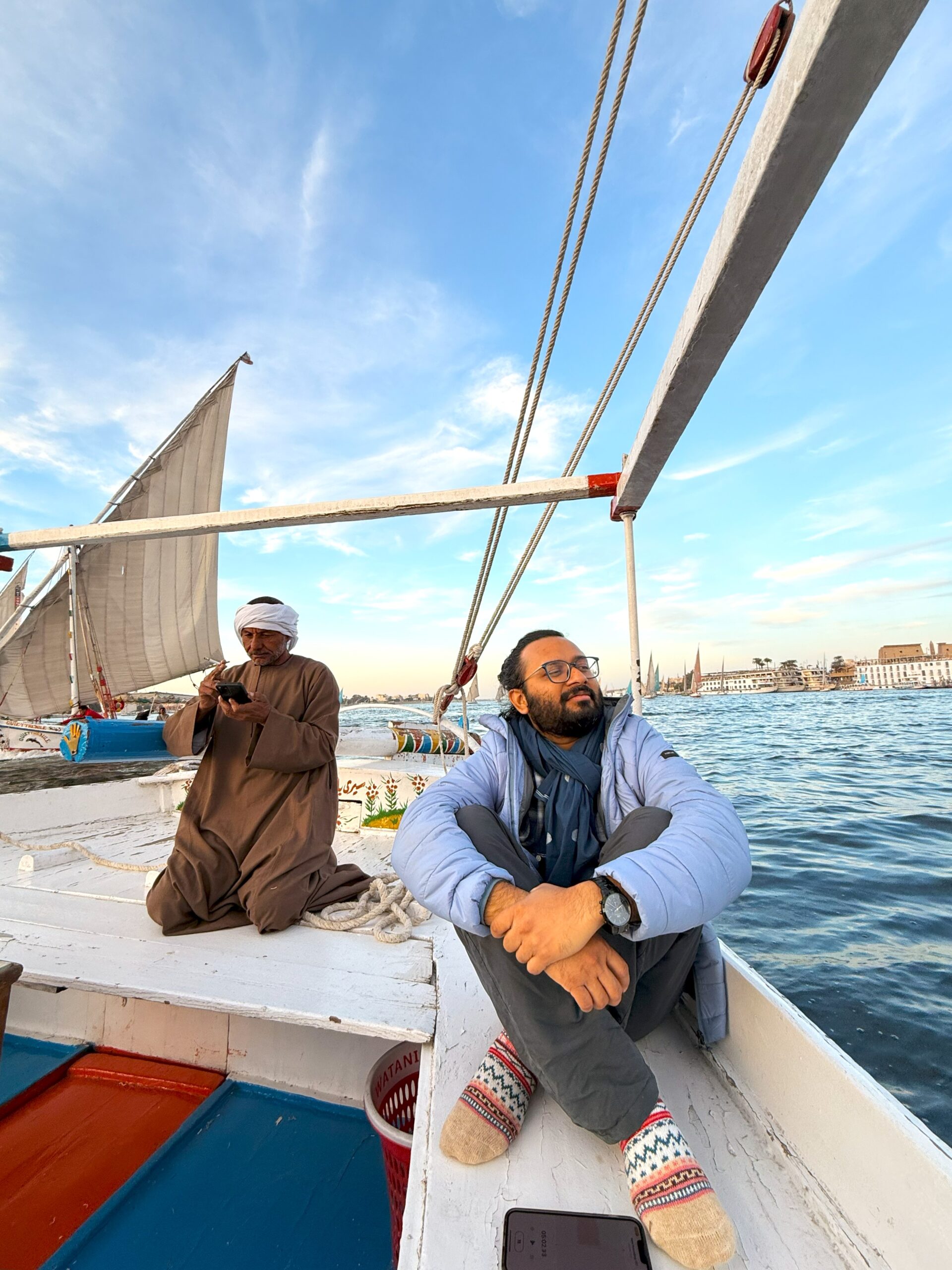
14. Go for dinner at the Winter Palace Hotel (Sofitel Winter Palace) in Luxor
One of our most special evenings in Luxor was dinner at the historic Winter Palace Hotel, now the Sofitel Winter Palace. This grand colonial-era property, overlooking the Nile, is steeped in old-world charm and elegance. With its sweeping staircases, antique furnishings, and manicured gardens, stepping inside felt like entering a different era.
We chose this beautiful spot to celebrate Sourav’s birthday, and it couldn’t have been more perfect. The staff were incredibly warm and gentle (quietly attentive without being overbearing), and they made sure the evening felt personal and memorable.
15. Explore the Philae Temple in Aswan
Visiting Philae Temple in Aswan was one of those experiences that felt quietly magical. We took a small boat across the Nile to reach Agilkia Island, where the temple now stands. As we approached, the silhouette of its columns and carvings slowly emerged against the water and sky—it felt like discovering something sacred, tucked away from the world.
Dedicated to the goddess Isis, Philae Temple is beautifully preserved, and what makes it even more incredible is its story. It was originally located on Philae Island but had to be moved piece by piece in the 1960s to save it from rising waters after the Aswan High Dam was built. Standing there, knowing it was rebuilt with such care, made the whole place feel even more special.
We wandered through its quiet courtyards, admired the intricate reliefs, and just took it all in. Since we visited the Philae Temple in the evening, we stayed back for the Light and Sound Show here as well.
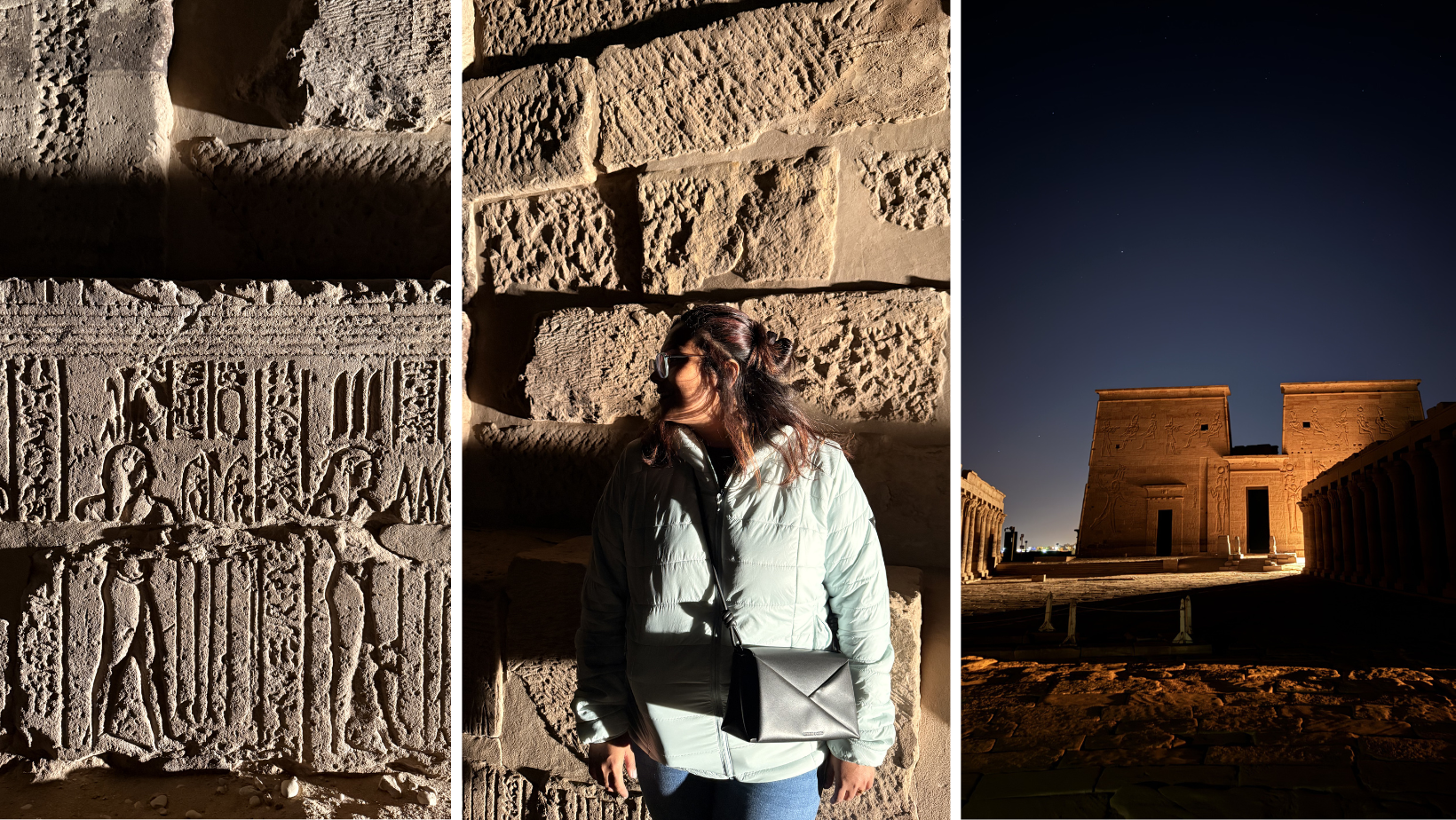
16. Take a day trip to Abu Simbel from Aswan
If I had to say one thing in Egypt that I loved the most, it has to be the Temple of Abu Simbel.
On a day trip from Aswan, visiting the magnificent Temple of Abu Simbel felt like stepping into a scene from a movie I’d long admired. I first saw this awe-inspiring monument in Death on the Nile, and its striking image has been etched in my heart ever since. To finally stand before it, after seeing it on screen, was a surreal experience that made history come alive in a way no film could fully capture.
The journey itself is part of the magic. Travelling about 280 kilometres southwest of Aswan, the road stretches across vast expanses of the Nubian Desert. The barren yet mesmerising desert landscapes, with endless golden sands under a crisp blue sky, create a sense of anticipation. As the miles pass, the anticipation builds, knowing that soon I will come face-to-face with one of ancient Egypt’s most iconic masterpieces.
When Abu Simbel finally emerges on the horizon, its grandeur is overwhelming. The twin temples are carved directly into towering sandstone cliffs, their entrances guarded by four colossal statues of Ramses II, each towering nearly 20 meters high. These statues are so immense and finely detailed that they seem almost lifelike, their expressions carved with such skill that you can almost sense the power and presence of the pharaoh himself. The sheer scale of these statues and the precision of the carvings inside the temples live up to every bit of that cinematic grandeur I had imagined.
Inside the temples, the walls tell stories of Ramses II’s victories and his divine connection to the gods, depicted in vibrant reliefs that have survived millennia. Walking through these halls, it felt as if I were travelling back in time, surrounded by the echoes of a civilisation that shaped history.

17. Go for a ‘High Tea’ at the Sofitel Old Cataract Hotel in Aswan
While in Aswan, we had the pleasure of dining at the iconic Sofitel Old Cataract Hotel, a place steeped in history and charm. This grand hotel is famously where Agatha Christie stayed while writing her classic novel Death on the Nile back in 1937. The very desk where she penned the Poirot mystery remains preserved within the hotel, and there’s even a suite named in her honour.
Although many visitors come for the famed afternoon high tea on the terrace, complete with cakes, scones, and delicate sandwiches, the magic of the place is just as tangible over dinner. As we enjoyed our meal, the warm and attentive staff added to the experience, making it feel both elegant and welcoming.
Outside, the timeless view of felucca boats lazily drifting down the Nile lent an entirely Egyptian character to the evening, perfectly blending the hotel’s British colonial heritage with the enchanting Nile River setting. It was a dinner that felt like a journey through time, wrapped in luxury and literary history.
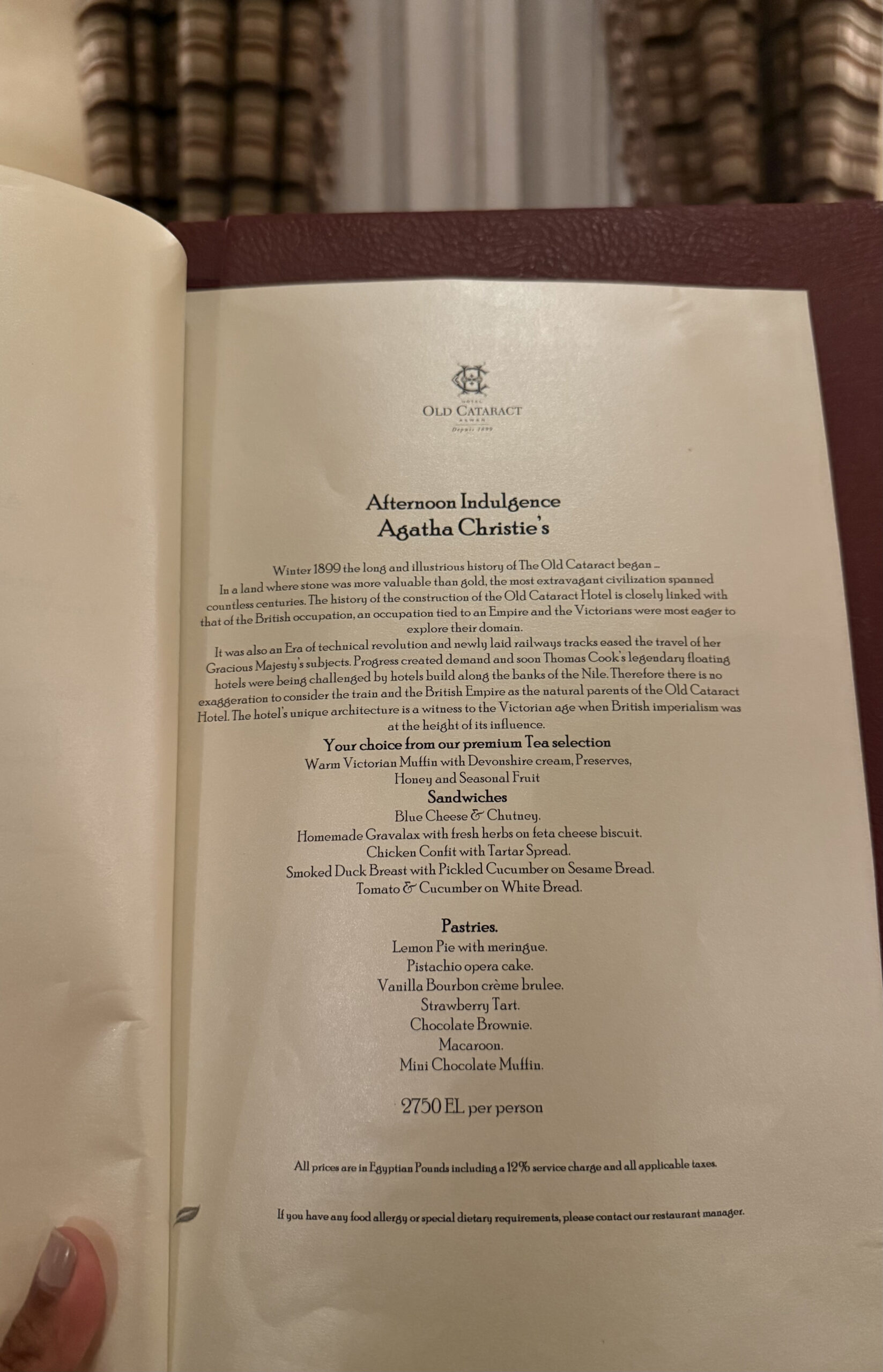
18. Visit the Temples of Kom Ombo and Edfu on the way to Luxor from Aswan
On our road trip from Aswan to Luxor, we took the opportunity to stop at two fascinating ancient sites: the Temples of Kom Ombo and Edfu. While most travellers visit these as part of a leisurely Nile cruise, we chose the overland route, giving us the flexibility to explore at our own pace.
Our first stop was Kom Ombo, a unique double temple dramatically perched on a bend of the Nile. What makes it particularly interesting is that it’s dedicated to two gods simultaneously – Sobek, the crocodile god, and Horus, the falcon-headed sky god. This rare dual dedication is reflected in its symmetrical design, with twin halls and sanctuaries. Don’t miss the Crocodile Museum nearby, home to mummified crocodiles that once symbolised Sobek’s divine presence.
Next, we visited Edfu, home to one of the best-preserved temples in all of Egypt. Dedicated to Horus, the Edfu Temple is a stunning example of Ptolemaic architecture, with soaring stone walls, intricate reliefs, and a massive pylon at the entrance. Walking through its collonaded halls, you can almost hear the chants of ancient priests. The myths of Horus’s victory over Seth come alive on the temple walls, making it not just visually impressive but also rich in storytelling.
Though often overshadowed by Luxor’s grandeur, these temples offered a more intimate glimpse into Egypt’s layered past, making the road trip all the more worthwhile.

19. Spend a couple of leisurely days in Sahl Hasheesh
While most travellers heading to the Red Sea gravitate towards the popular resort towns of Hurghada or Sharm el-Sheikh, we chose to take the road less travelled and spent a couple of leisurely days in Sahl Hasheesh – a quieter, more refined gem along the coast.
Tucked just 20 minutes south of Hurghada, Sahl Hasheesh is a purpose-built resort town, but it manages to feel serene rather than commercial. With wide palm-lined boulevards, elegant architecture, and a long stretch of golden beach lapped by clear turquoise waters, it’s the kind of place where time slows down. The pace here is delightfully unhurried—perfect for lazy mornings by the sea, long swims, and sunset strolls along the pier.
Unlike the crowded beaches of its neighbours, Sahl Hasheesh offers space and stillness. We spent our days soaking up the sun, exploring coral reefs on a relaxed snorkelling trip, and lingering over seafood lunches with sweeping views of the Red Sea. There’s a calm elegance to the town – less about the nightlife, more about reconnecting with nature, with your thoughts, or simply with each other.
For anyone seeking a peaceful seaside escape in Egypt, Sahl Hasheesh is a beautiful detour from the usual Red Sea circuit, and one I’m glad we took.
Note: We stayed at Pyramisa Beach Resort in Sahl Hasheesh, and it turned out to be the perfect place to unwind after days of exploring Egypt’s ancient wonders. Nestled right along the Red Sea, the resort offered a beautiful blend of comfort, calm, and warm hospitality.
20. Experience the Nile Cruise in Cairo (Sunset Cruise with Dinner)
One of the most memorable ways to experience Cairo is by taking a sunset dinner cruise on the Nile, a chance to see the city from a different perspective, as it transforms from day to night. We booked a two-hour evening cruise that included a lavish buffet dinner and live entertainment, and it turned out to be the perfect way to end a packed day in the capital.
As the boat gently glided along the Nile, Cairo’s skyline shimmered in the fading light. The contrast was striking—on one side, modern high-rises and bustling city life; on the other, glimpses of timeless minarets and bridges lit up against the dusky sky. The sunset cast golden reflections on the water, and the gentle breeze offered a welcome break from the day’s heat.
Dinner was served buffet-style, with a generous spread of Egyptian and international dishes, fresh salads, grilled meats, warm breads, and rich desserts. But beyond the food, it was the live performances that really brought the evening to life. A spirited Tanoura dancer spun endlessly in vibrant, layered skirts – a whirling display of colour and rhythm. This was followed by an energetic belly dancing show, accompanied by traditional Arabic music. The atmosphere was festive but intimate, with just the right mix of culture and celebration.
While we couldn’t fit everything into our itinerary, Egypt is the kind of place that always leaves you wanting more. There were a handful of experiences we didn’t get to try, but they’re high on our list for next time, and definitely worth exploring if you have a few extra days. Here are some other unforgettable things to do in Egypt, should time (and curiosity) allow.
21. Take a trip to Alexandria
If you have a bit of extra time, head north to Alexandria, the Mediterranean city that once held the Great Library and the Lighthouse—two icons of the ancient world. Today, it’s a charming coastal city with a faded, nostalgic elegance. You’ll find crumbling colonial buildings, sea-facing cafés, and a promenade that invites slow evening strolls. The Bibliotheca Alexandrina is a modern marvel worth a visit, and the seafood here is some of the freshest in Egypt. It’s a place where Greek, Roman, and Egyptian histories intertwine. It is less chaotic than Cairo, and ideal for those seeking history with a side of sea breeze.
22. Explore the Siwa Oasis
Siwa feels like a world apart—remote, mystical, and completely unhurried. Tucked away near the Libyan border, this desert oasis is home to natural hot springs, salt lakes, and an indigenous Berber culture that’s unlike anywhere else in Egypt. You can explore the ruins of the ancient Oracle Temple (where Alexander the Great once sought prophecy), wander through a fortress made of mud-brick and salt, or just float in the incredibly buoyant Siwa Salt Lakes. It’s not the easiest to reach, but that’s part of the charm. Siwa is for those who want to disconnect, slow down, and truly immerse themselves in the desert’s rhythm.
23. Soak in the beauty of Fayoum
Just a couple of hours from Cairo, Fayoum is one of Egypt’s best-kept secrets. This lush basin surrounded by desert is full of surprises—ancient ruins, art communities, waterfalls, and even whale fossils in the middle of the desert at Wadi Al-Hitan (a UNESCO World Heritage Site). There’s a quiet magic to the region: wind-swept sand dunes, traditional pottery workshops in Tunis Village, and the serene waters of Lake Qarun. It’s ideal for a weekend getaway if you want a break from the cities without venturing too far. Fayoum is where Egypt’s ancient soul meets a slower, more creative way of life.
24. Visit the small town of Esna
Often overlooked in favour of Luxor or Aswan, Esna is a small Nile-side town that’s quietly reinventing itself. The restored Temple of Khnum, hidden behind shopfronts in the middle of a local souk, is reason enough to visit. But what’s even more exciting is the town’s ongoing cultural revival, with heritage buildings being lovingly restored and artisan-led experiences starting to pop up. You’ll find fewer tourists here, which makes interactions with locals feel more meaningful. If you’re interested in Egypt beyond the monumental, Esna gives you a glimpse of small-town life still deeply rooted in history and tradition.
25. Dive or snorkel in Dahab
Tucked away on the Sinai Peninsula, Dahab is a laid-back coastal town that quietly wins over everyone who visits. Far more relaxed than Sharm el-Sheikh, Dahab draws divers, free spirits, and slow travellers alike. Its crystal-clear waters are home to some of Egypt’s best dive sites, including the famous Blue Hole, a natural sinkhole teeming with marine life. Even if you don’t dive, the snorkelling here is spectacular. Beyond the sea, the town offers charming beachside cafés, golden mountains, and a boho vibe that invites you to stay longer than planned. It’s the Red Sea, but with soul.
26. Visit the Temple of Dendera
Often overlooked by mainstream itineraries, the Temple of Dendera is one of Egypt’s most beautifully preserved ancient sites and an absolute gem if you’re craving something a little off the beaten path. Located near Qena, north of Luxor, this temple is dedicated to Hathor, the goddess of love, music, and joy. One of the most fascinating features is the famous Dendera Zodiac, a celestial map etched into the ceiling of a chapel, reflecting the ancient Egyptians’ knowledge of astronomy.
Egypt had always lived in my imagination, in the pages of history books, in documentaries, in Agatha Christie novels, but being there felt like stepping into something far older and far more alive than I had ever expected. I thought I was coming for the monuments, but what truly surprised me was the energy of the place: chaotic yet grounded, ancient yet vibrant, always pulsing with stories waiting to be told.
Trust me when I say this, Egypt lingers long after you leave. And something tells me, I’ll be back.
If you’ve been to Egypt, do let me know about your favourite experiences in the comments below. And if there’s anything you think I missed out, please mention that too!
Disclaimer: This post contains a few affiliate links. If you happen to click on any of them and make a purchase, I might earn a small commission, at no extra cost to you. Just know that I truly appreciate your support if you choose to do so.
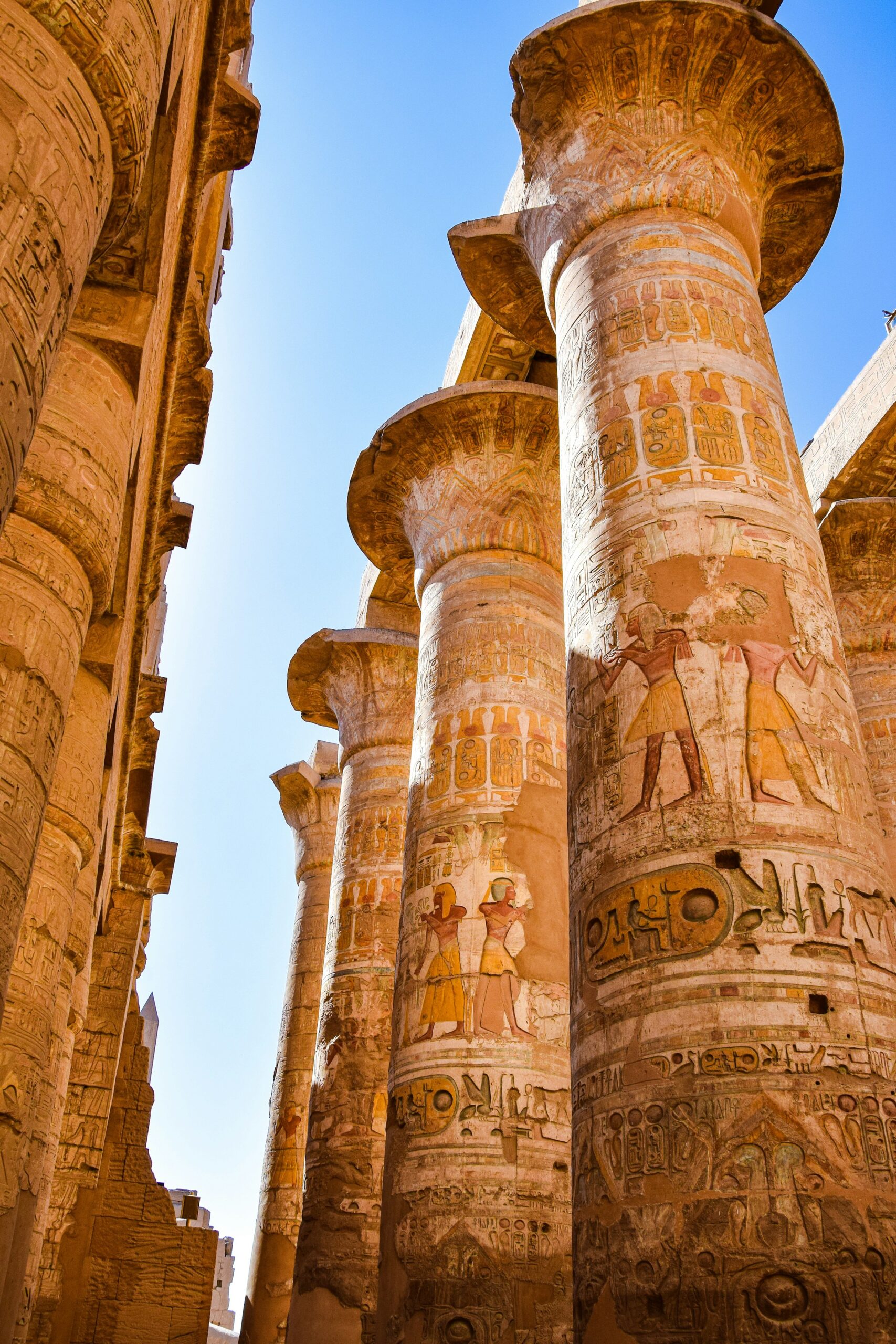
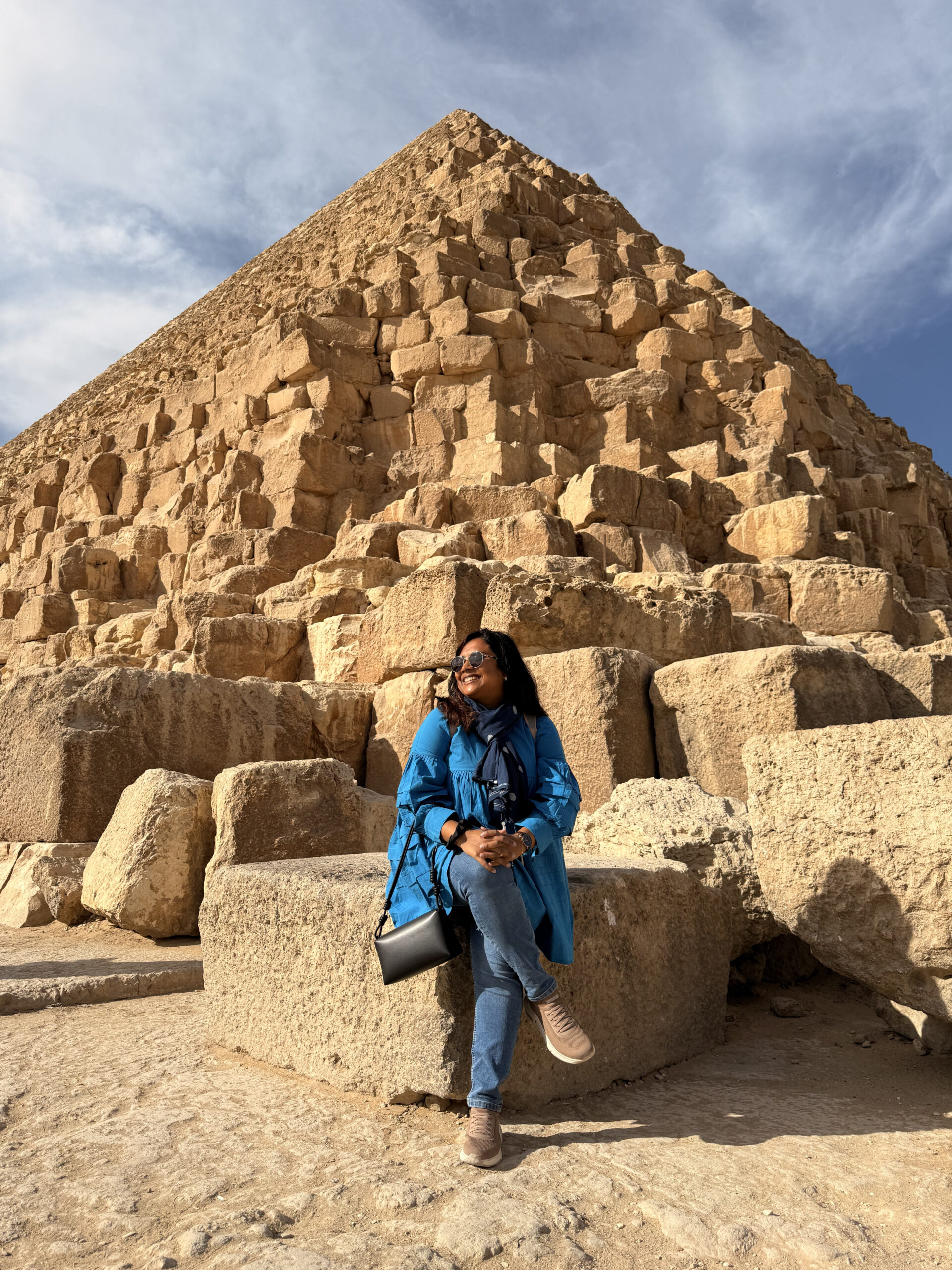

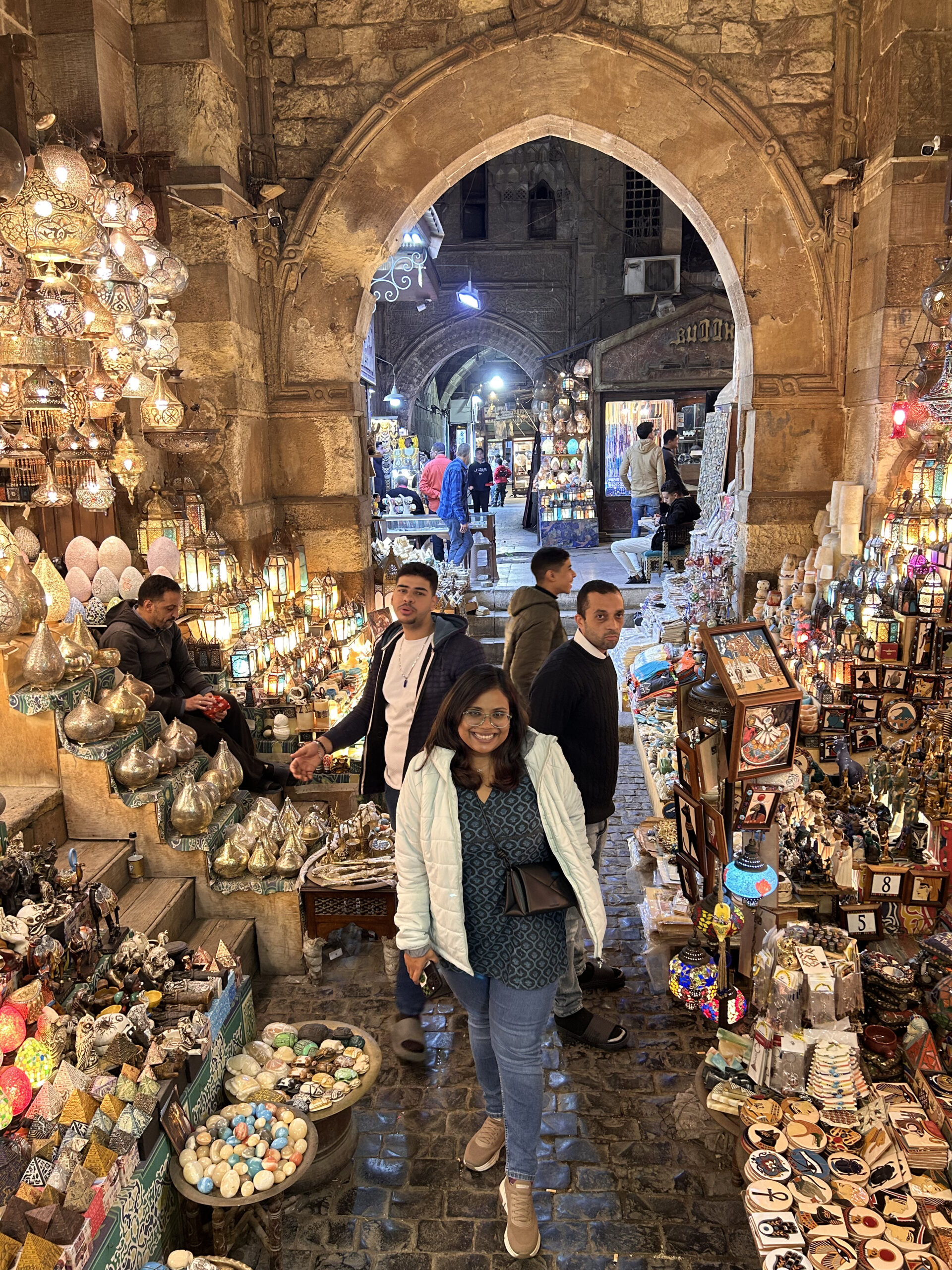
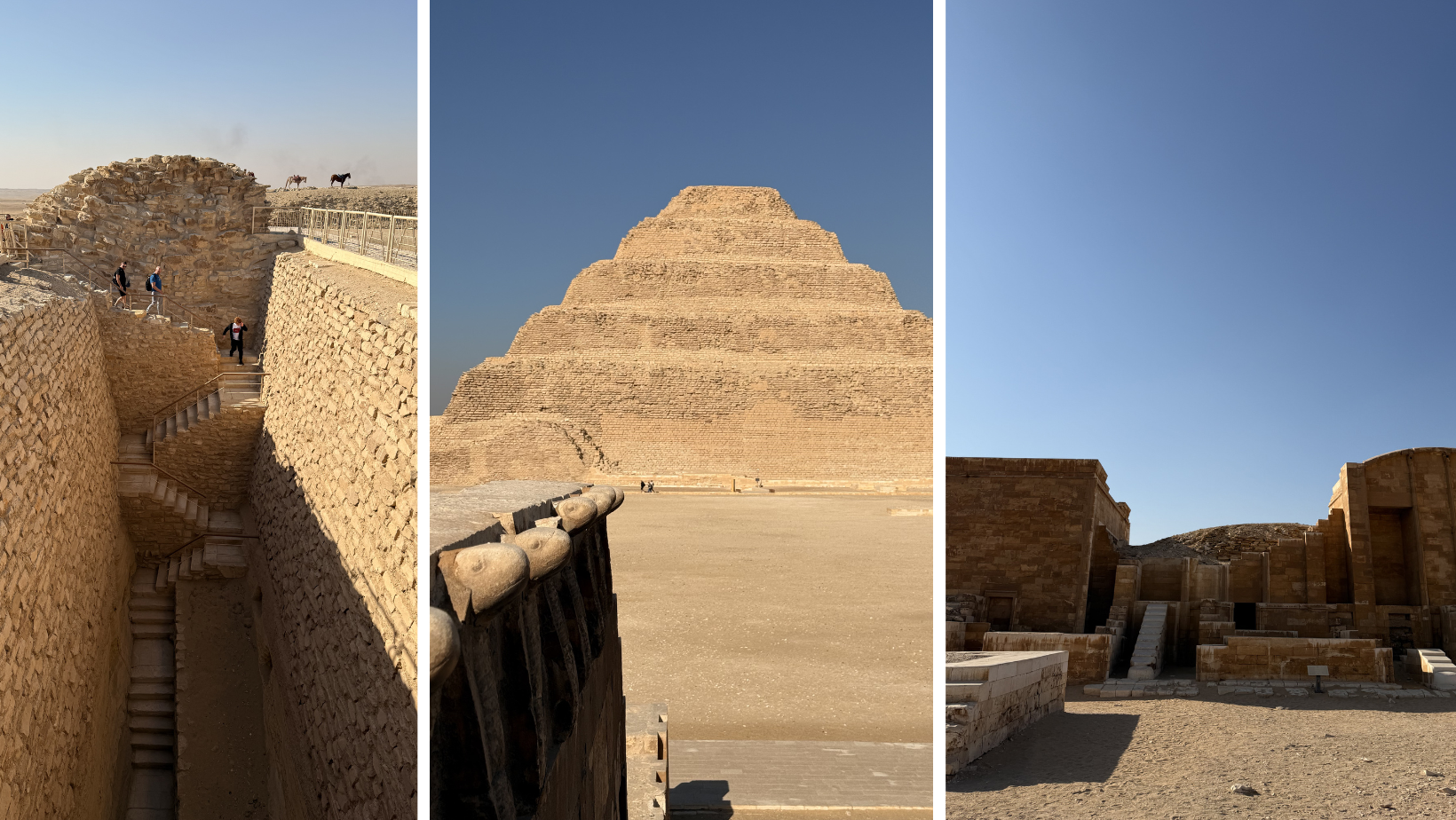
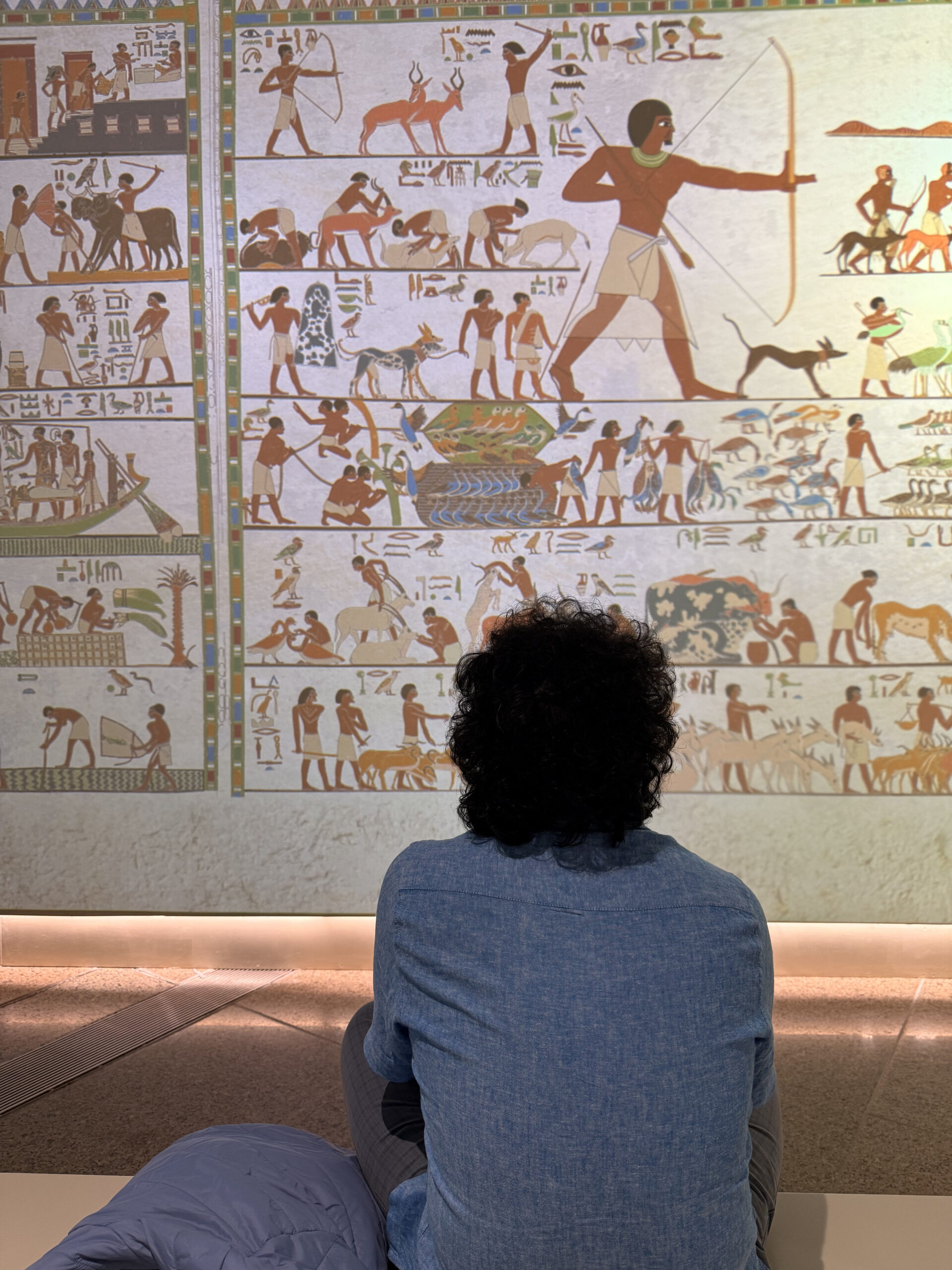
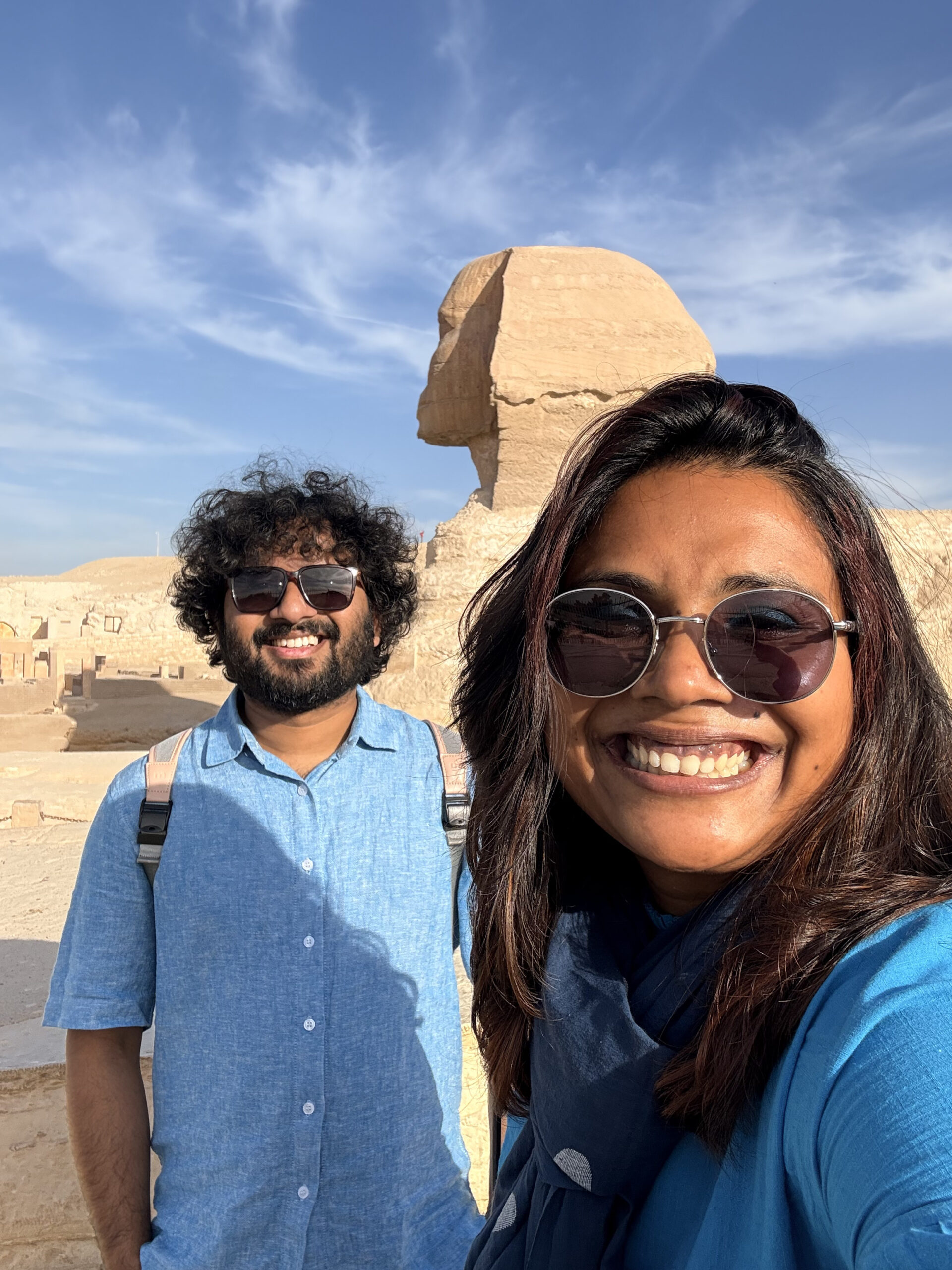
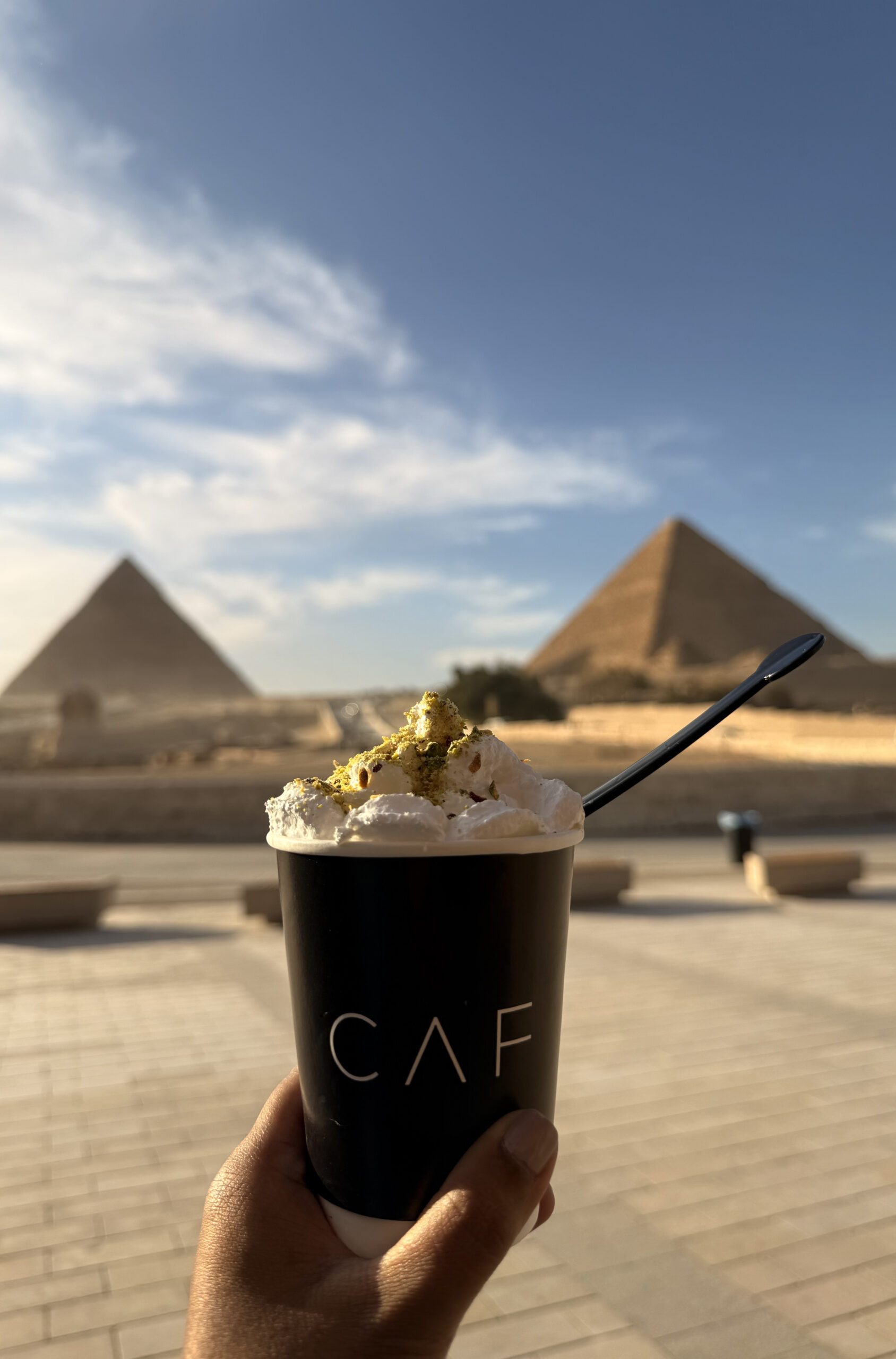
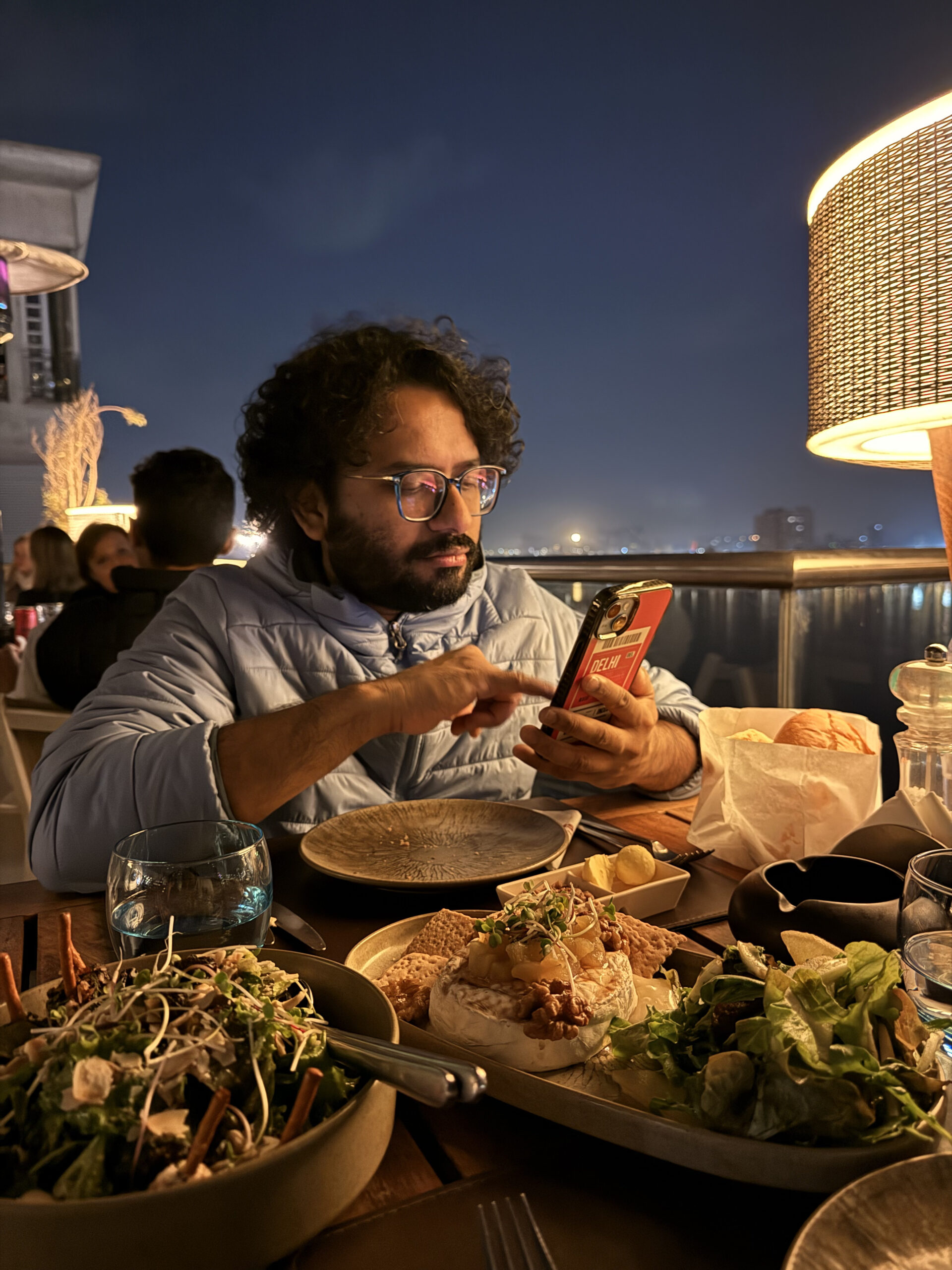
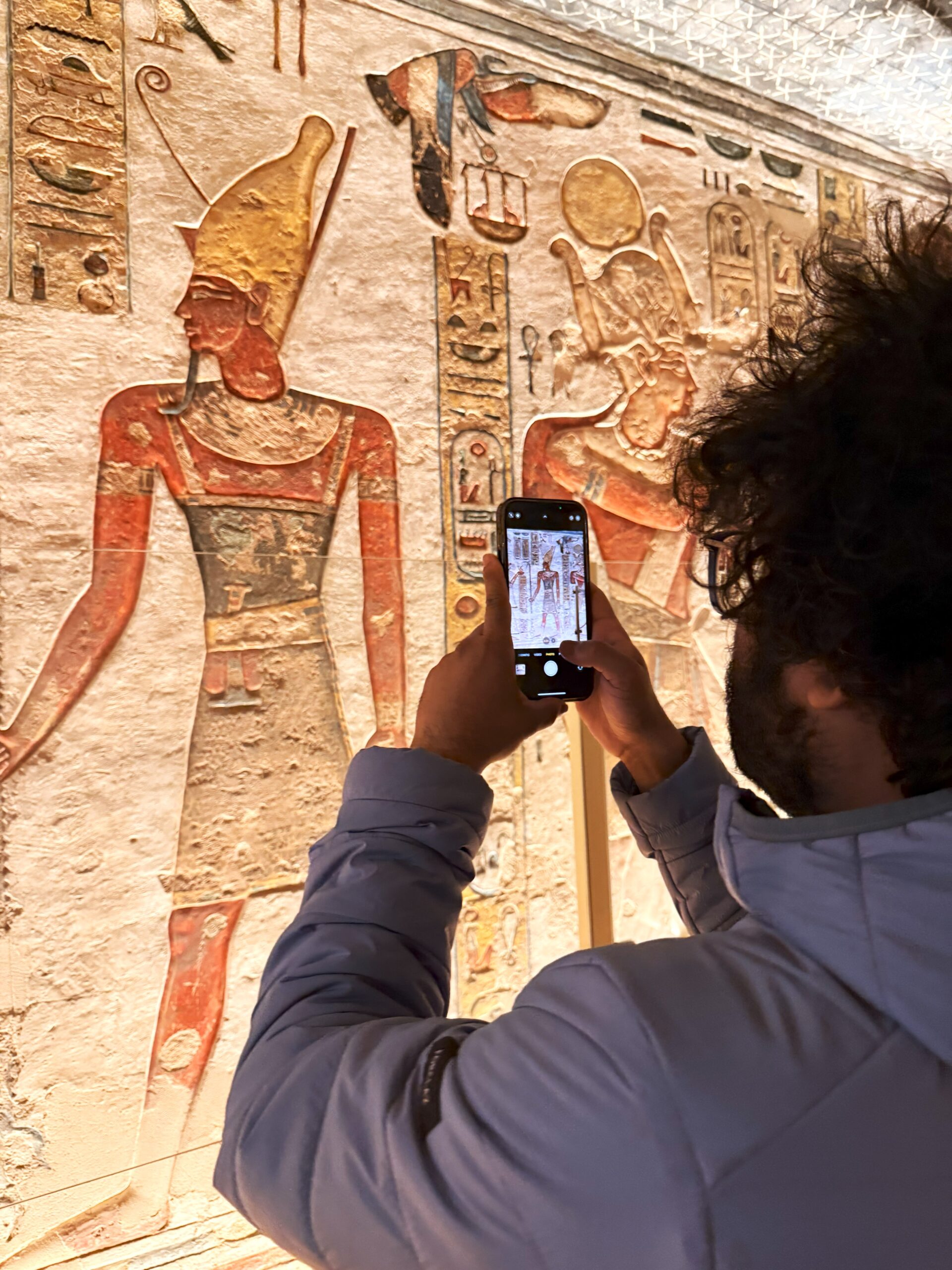

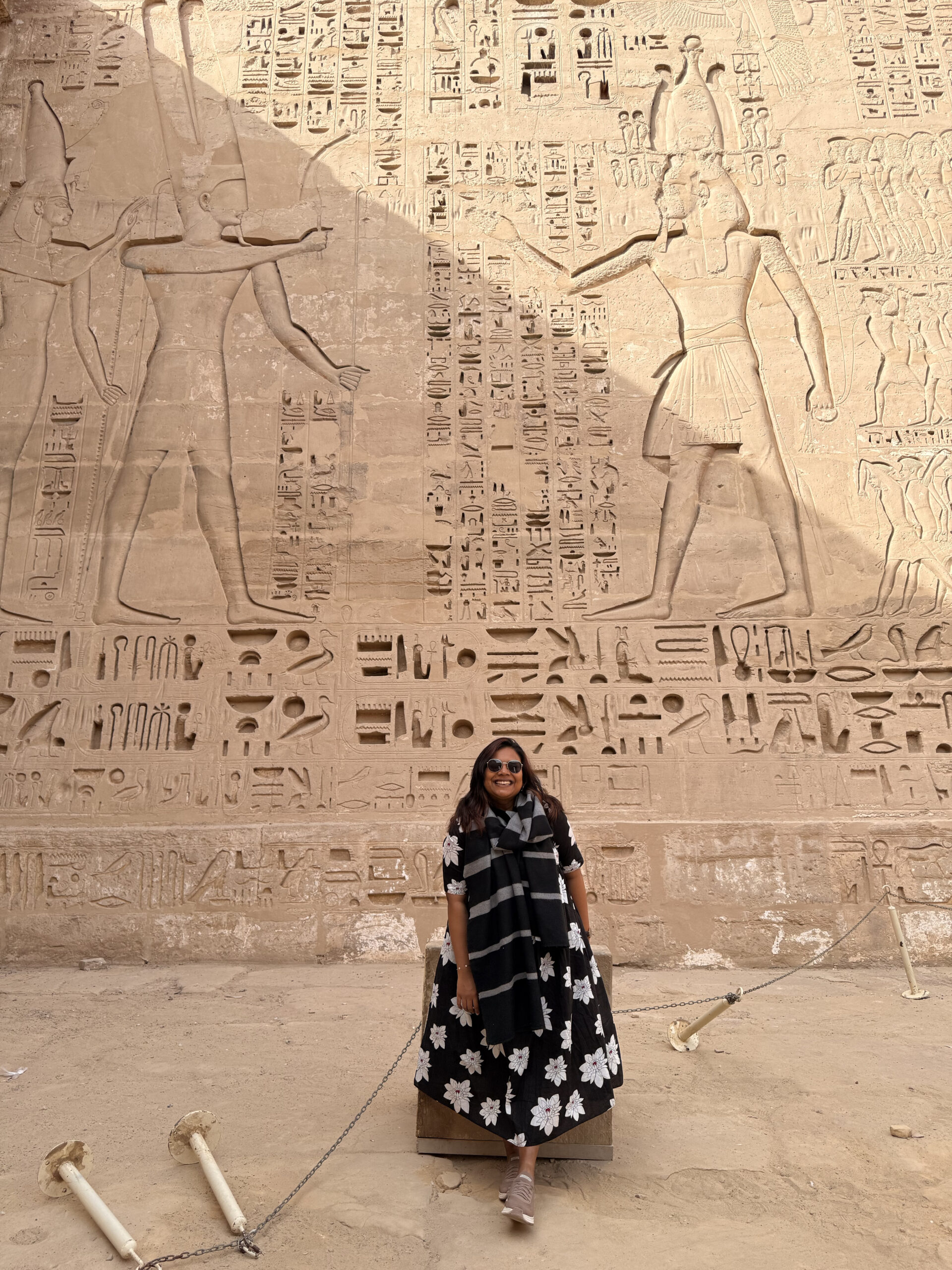
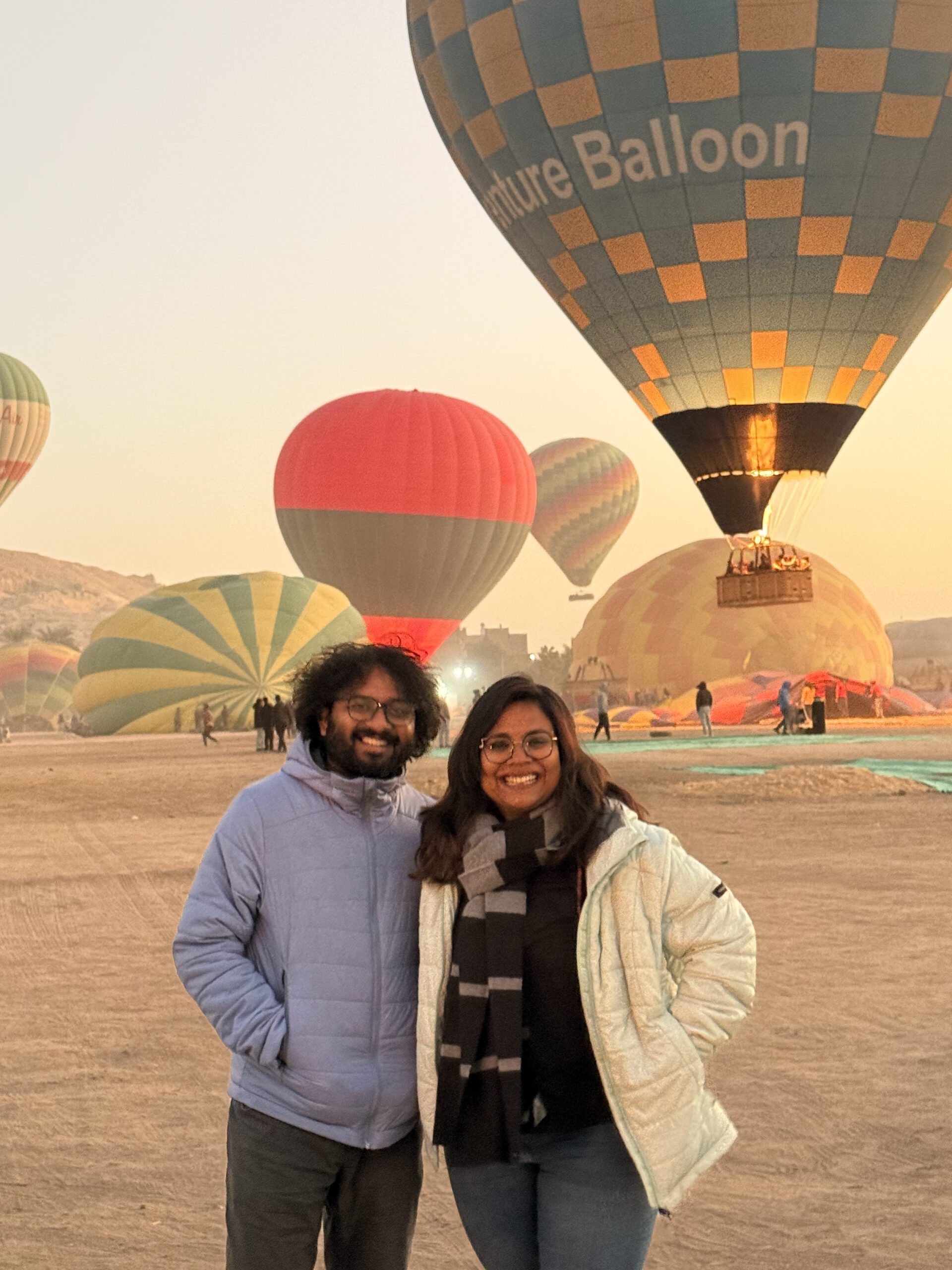
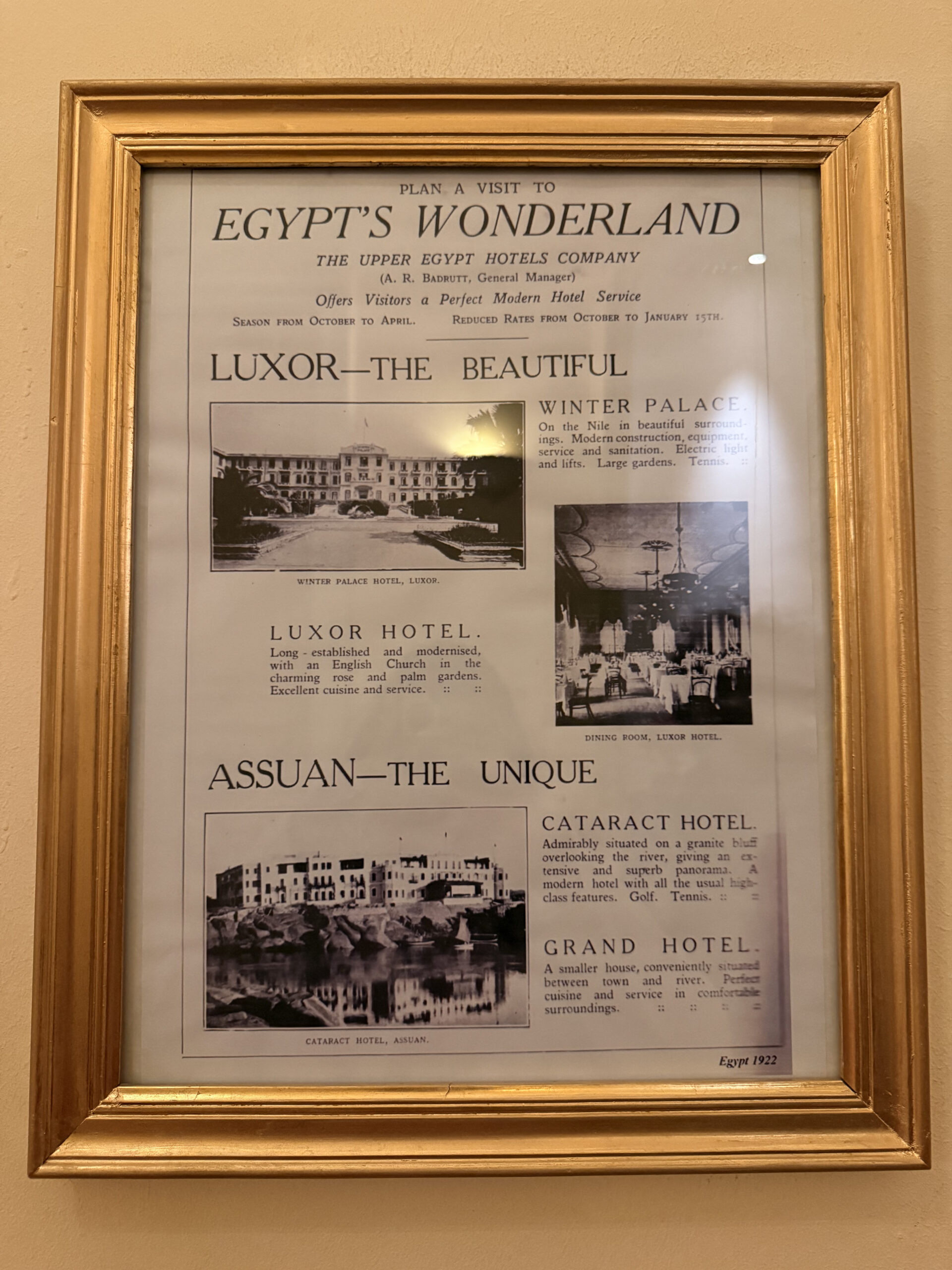
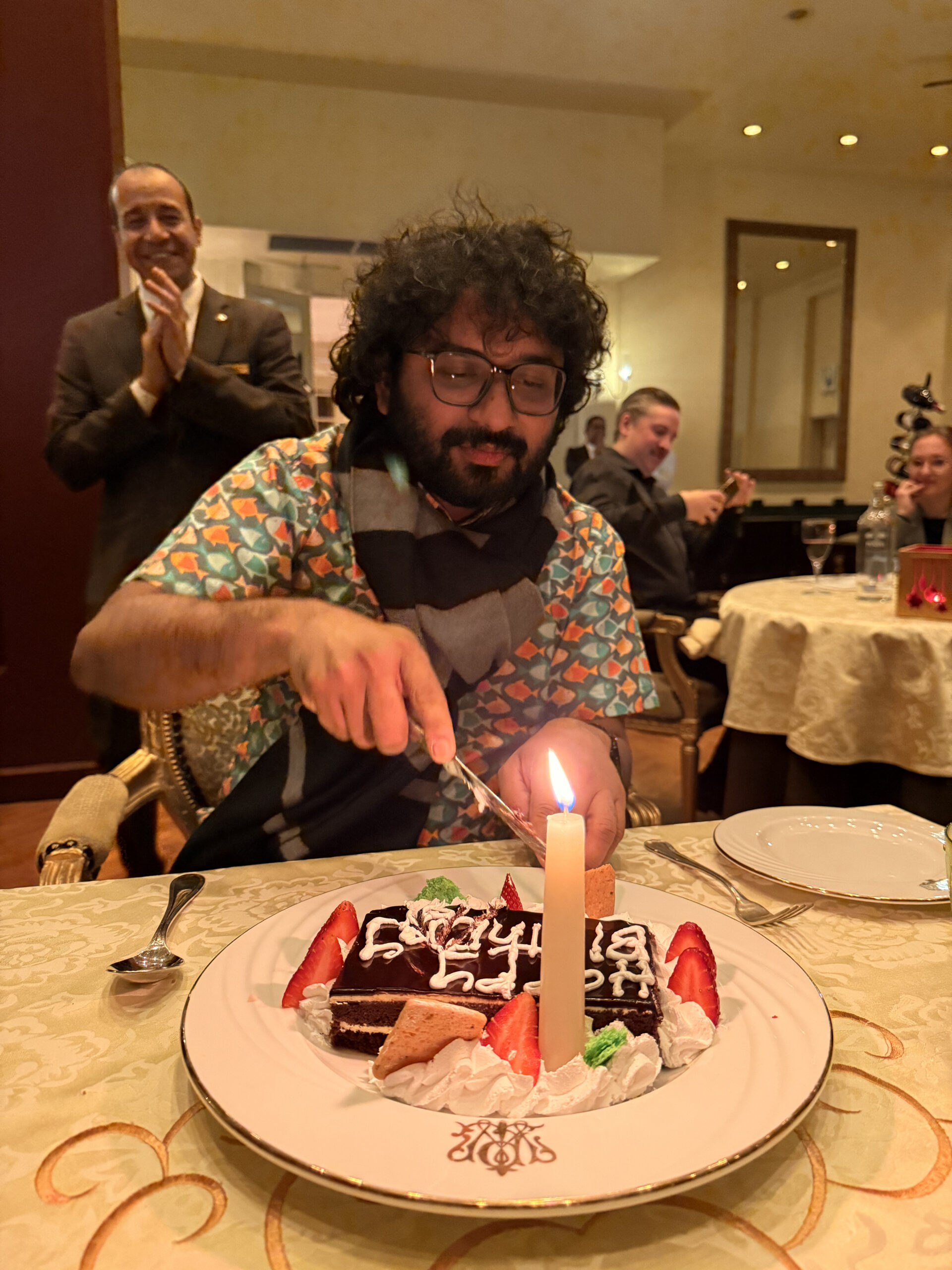
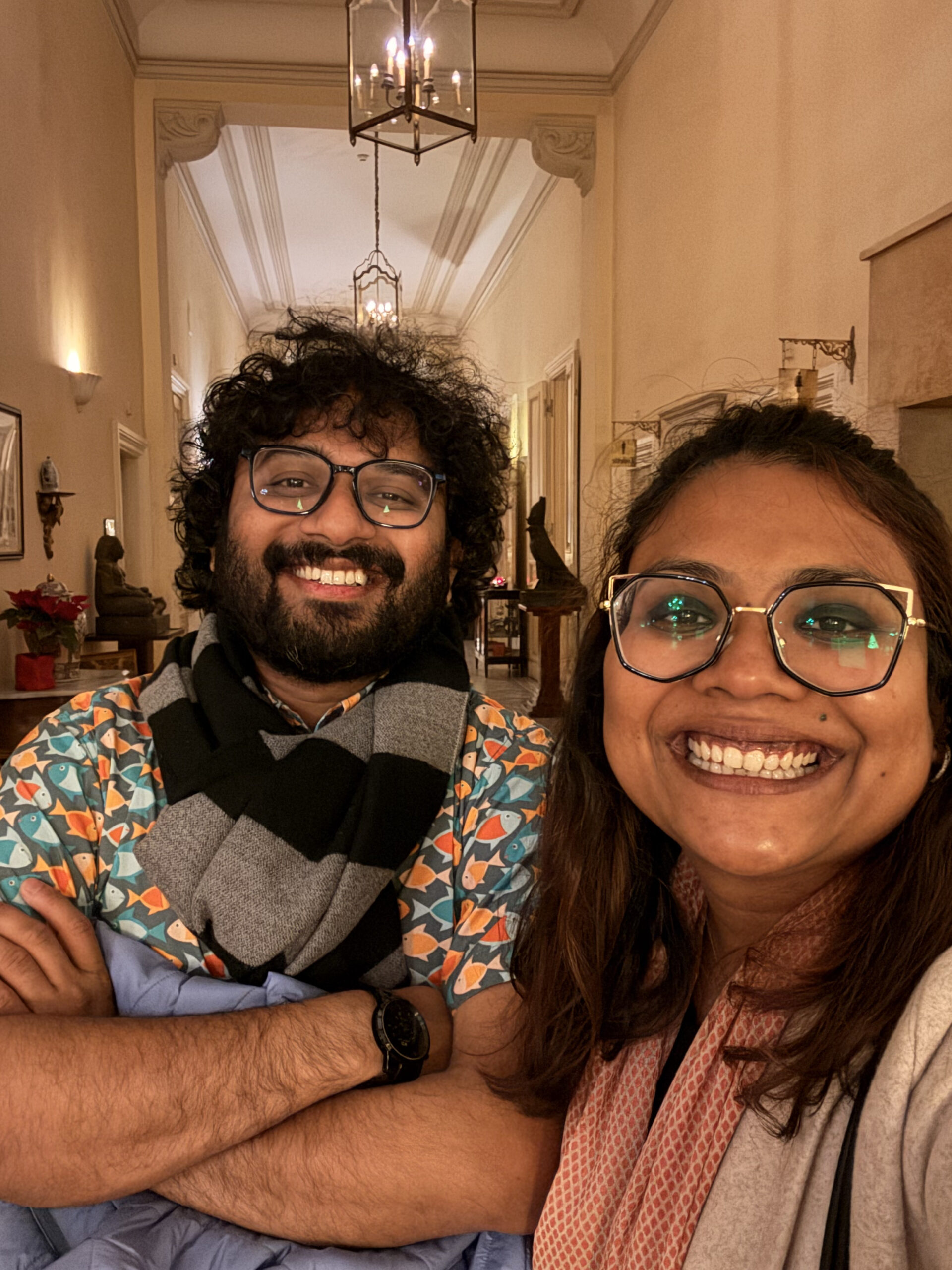
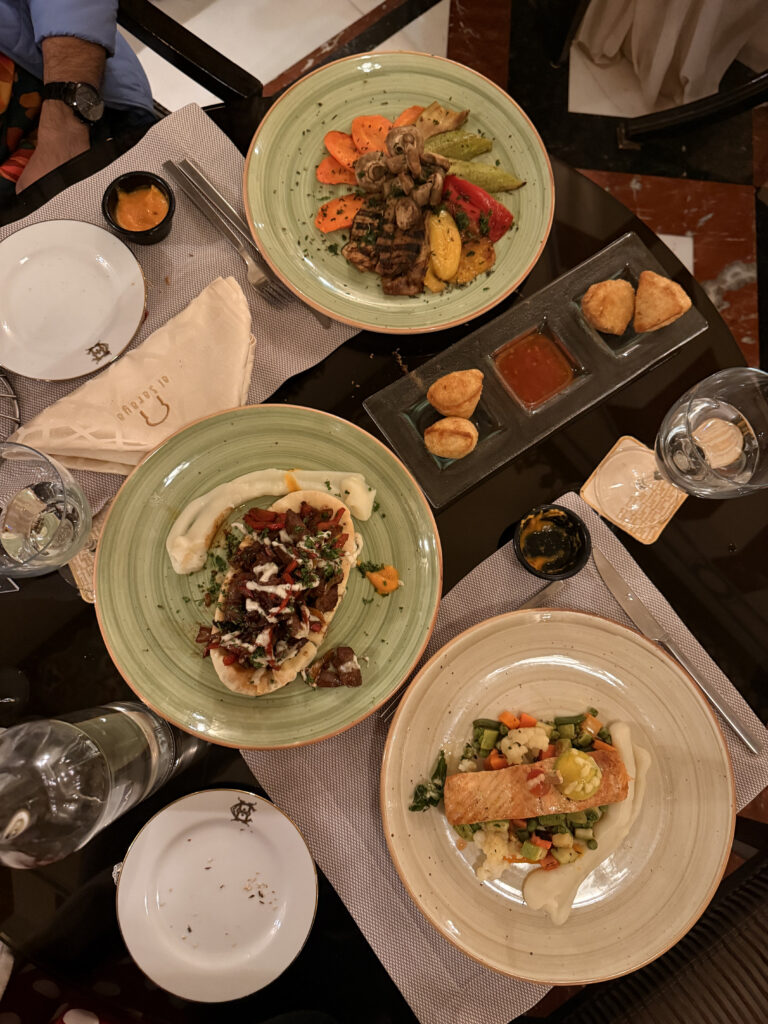
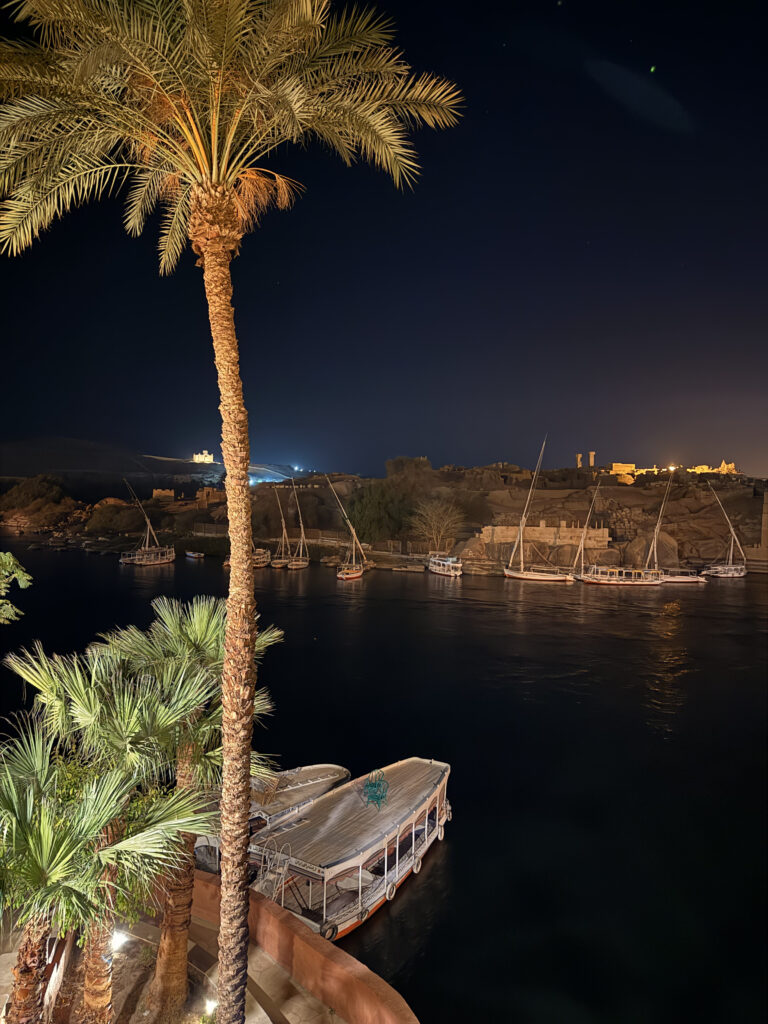

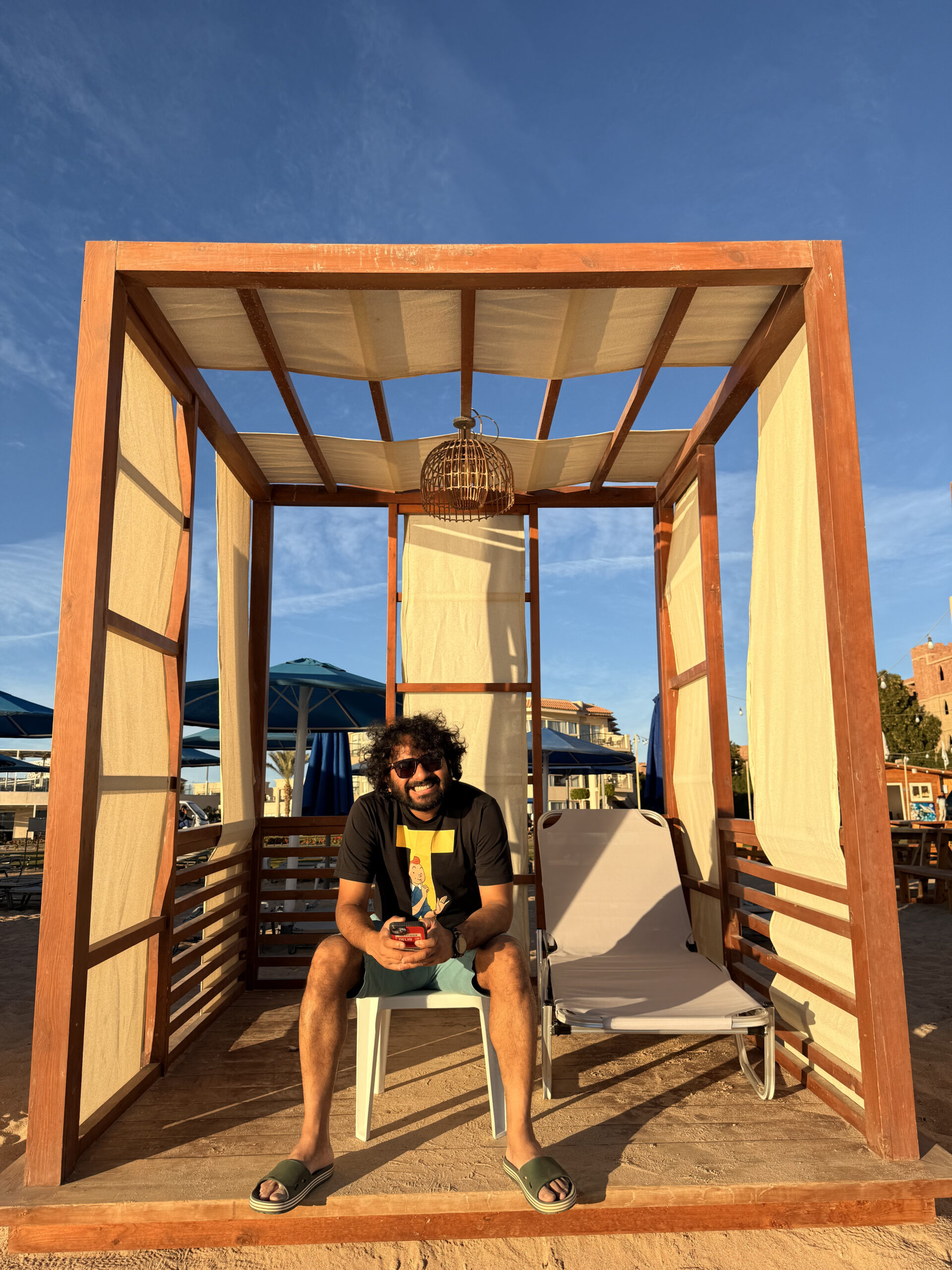
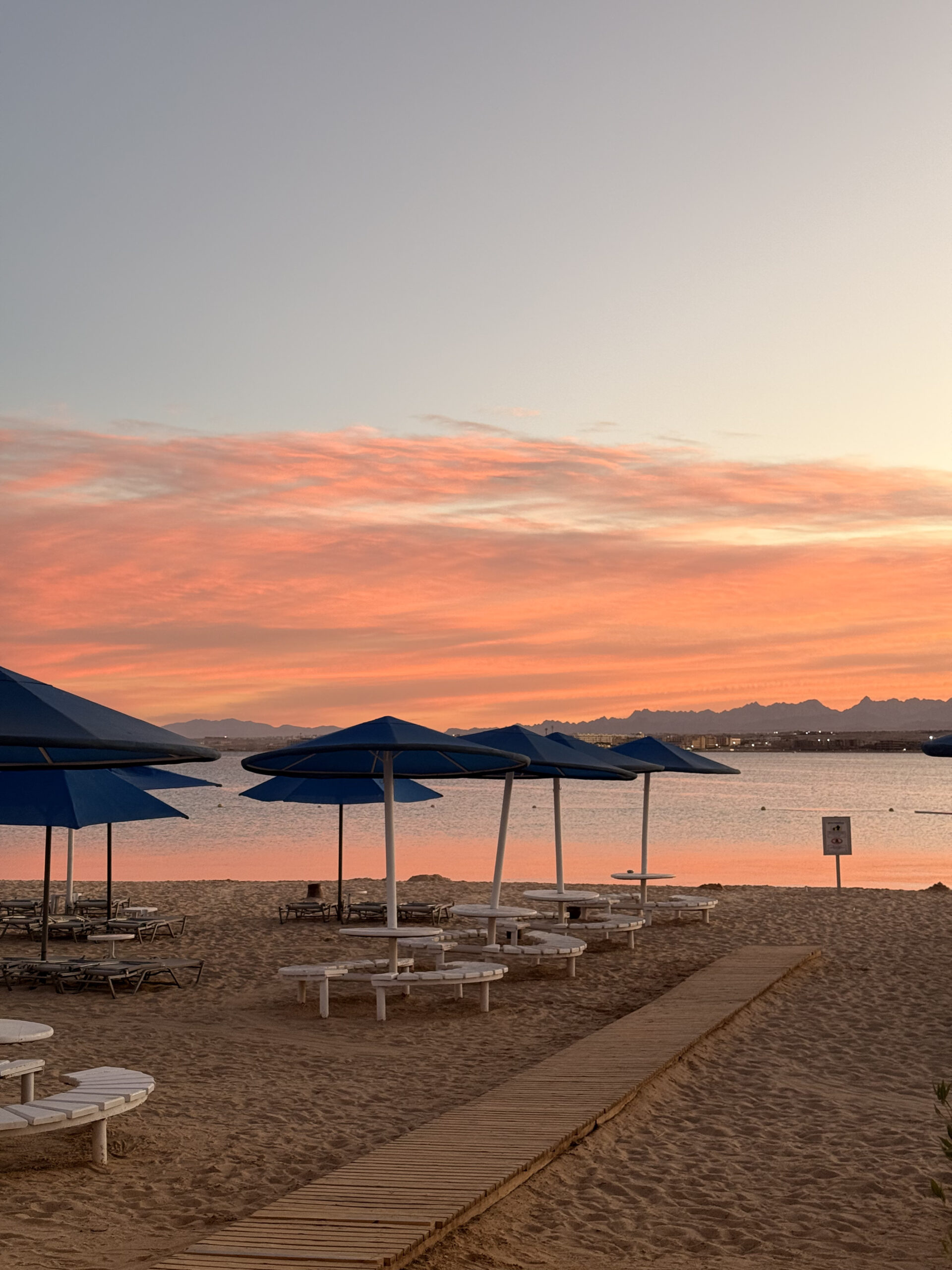
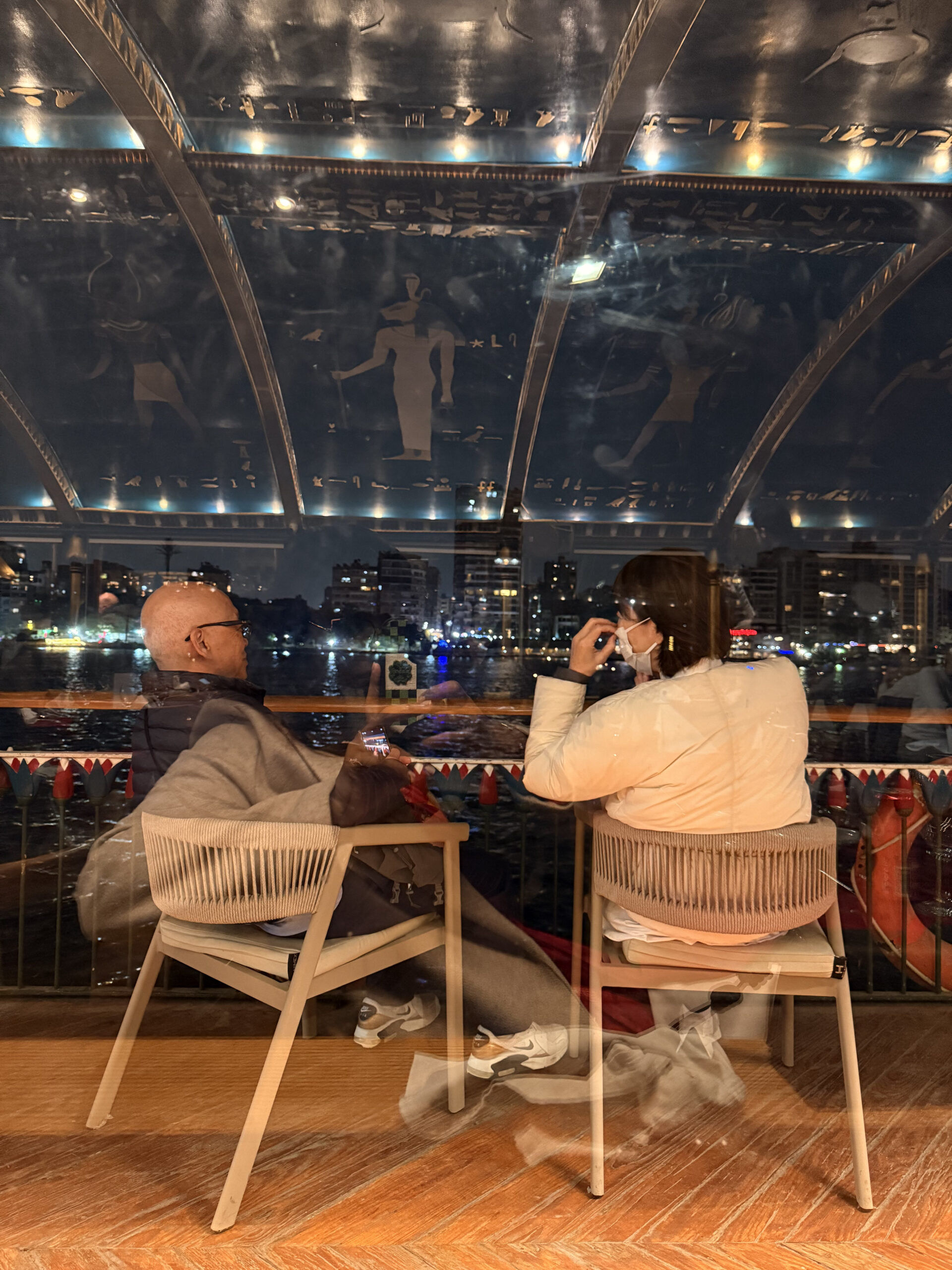
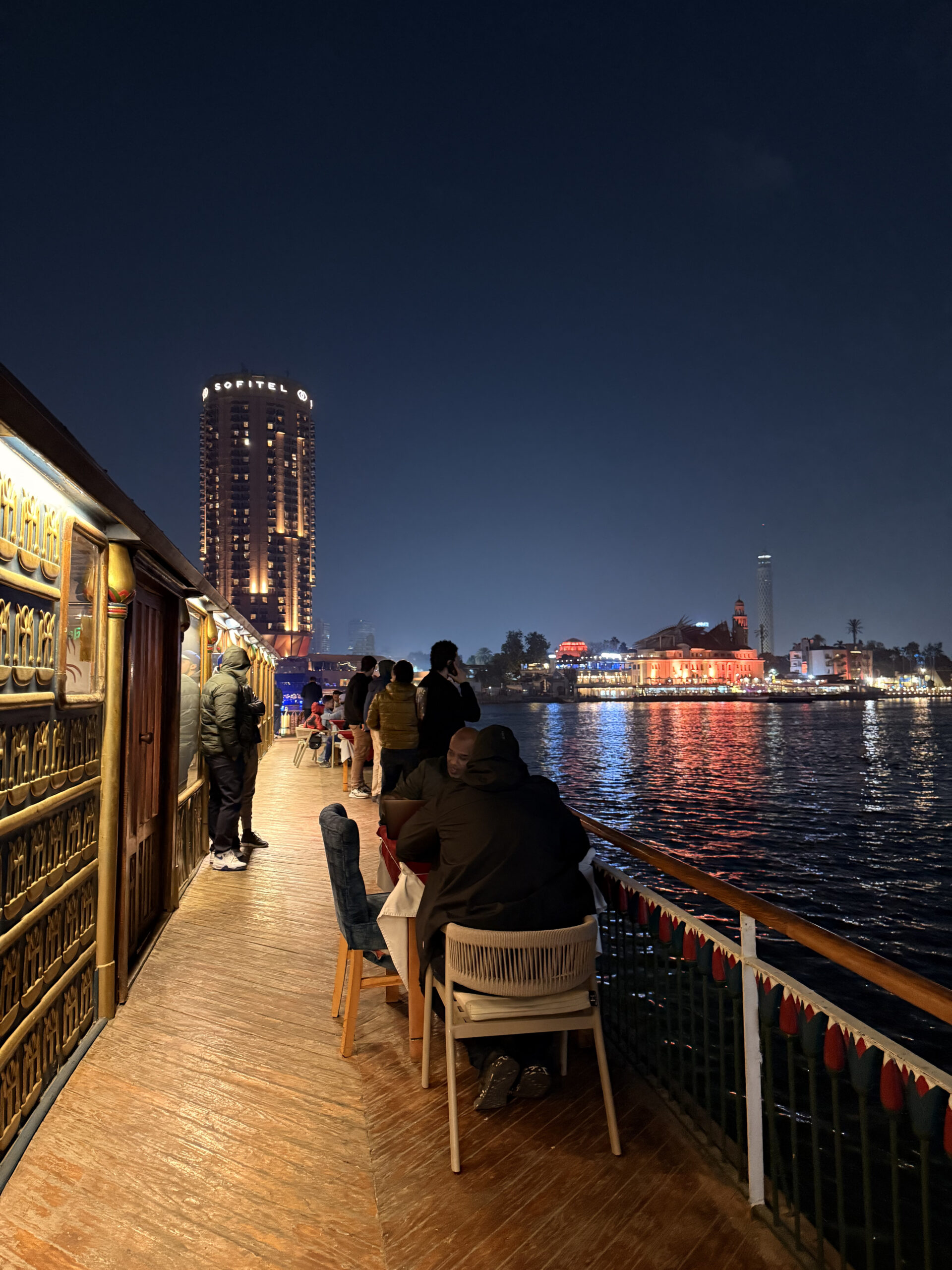
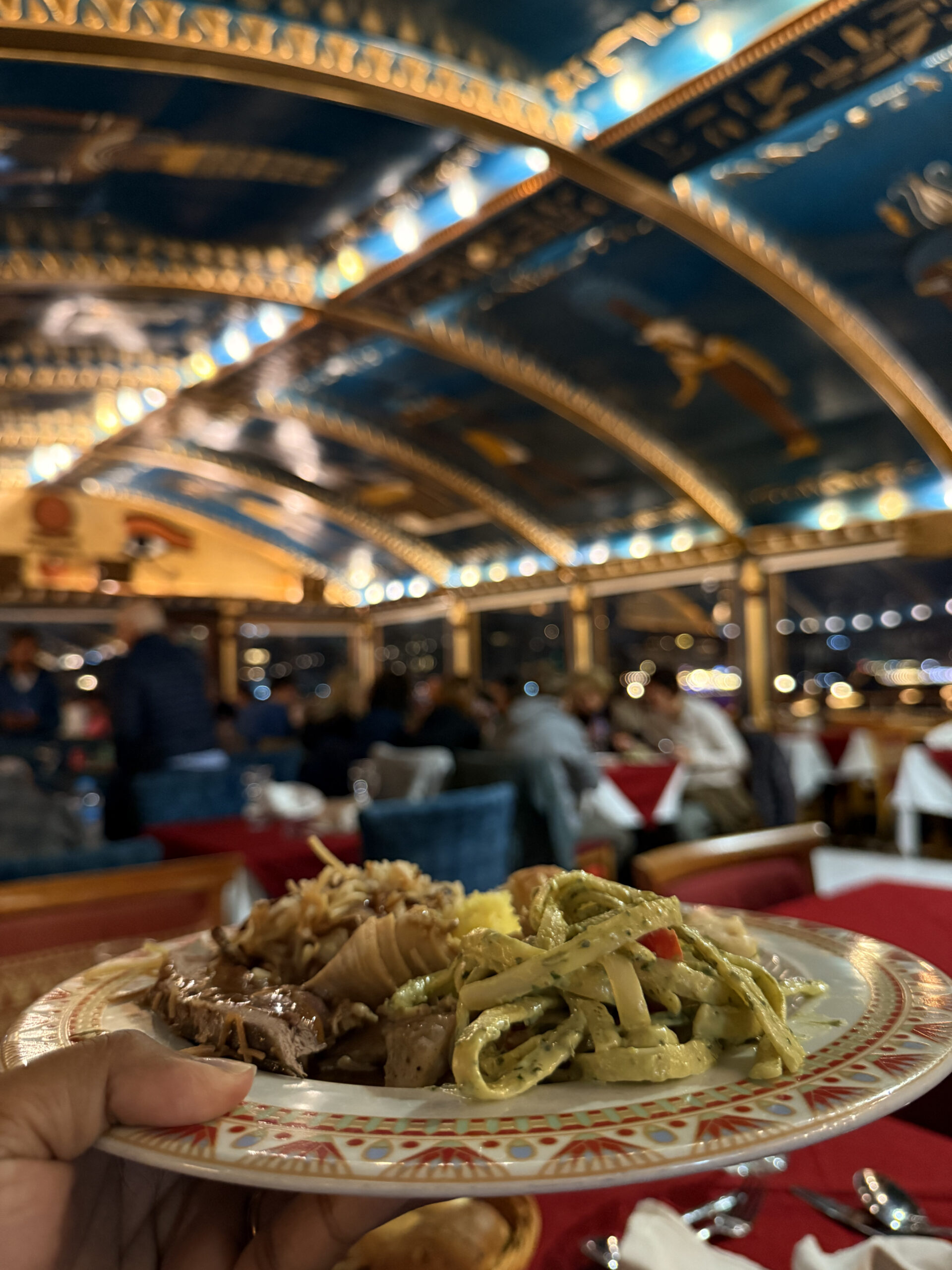

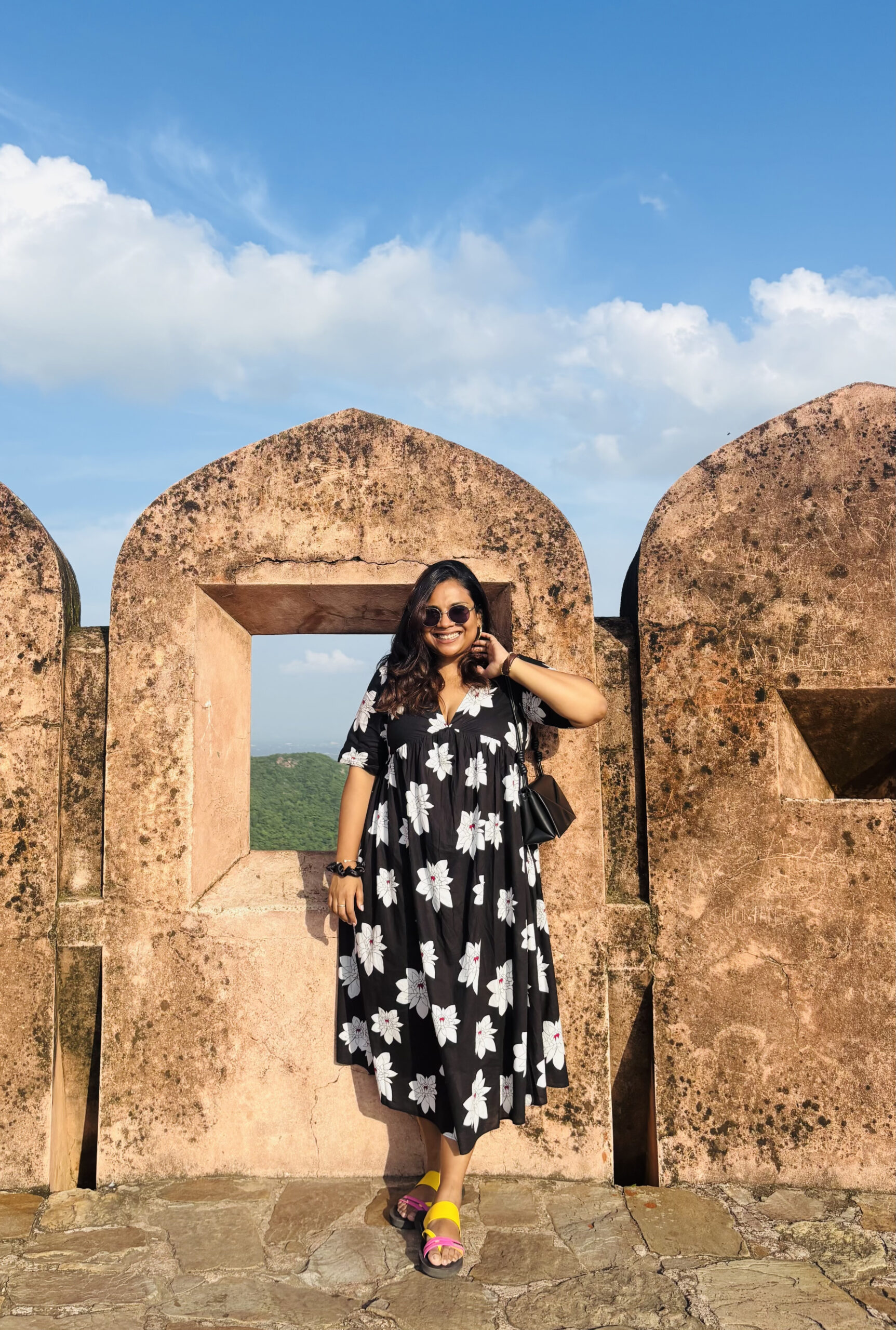


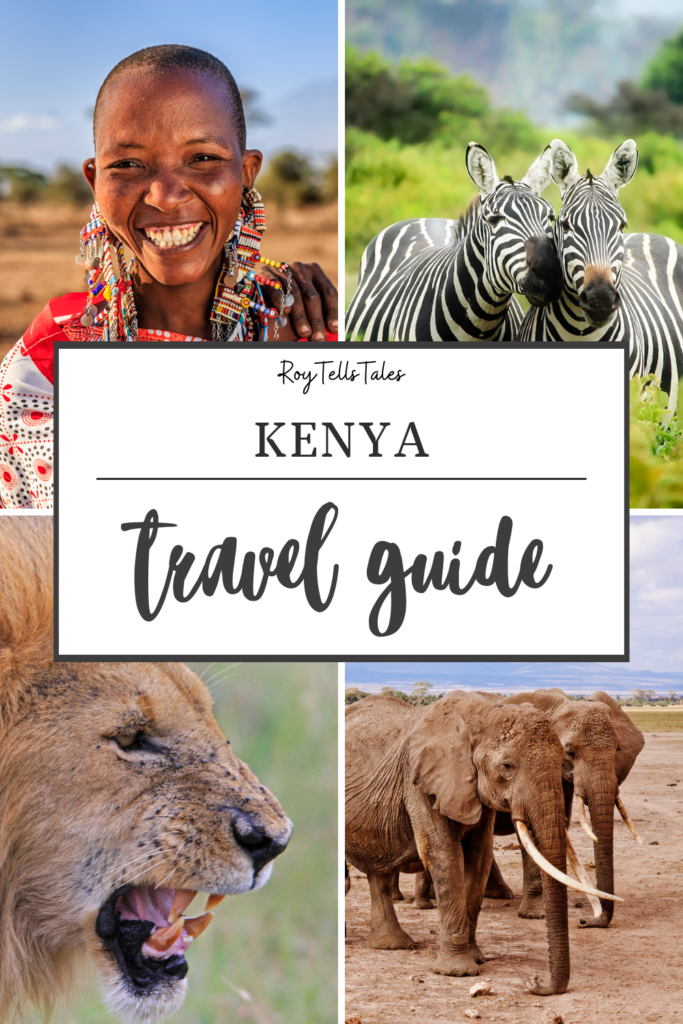
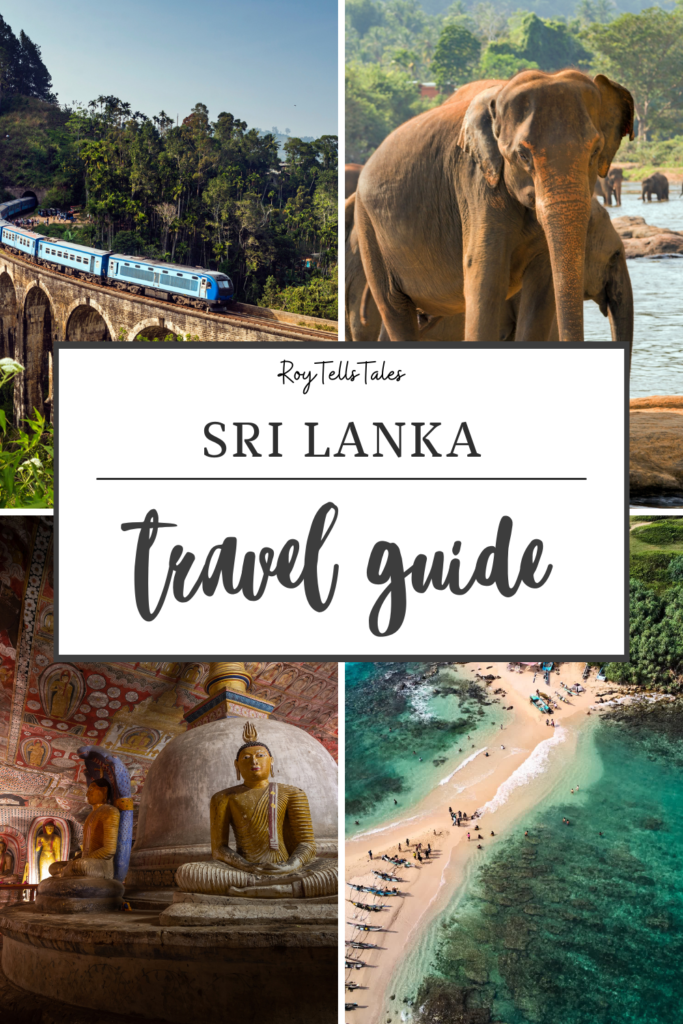

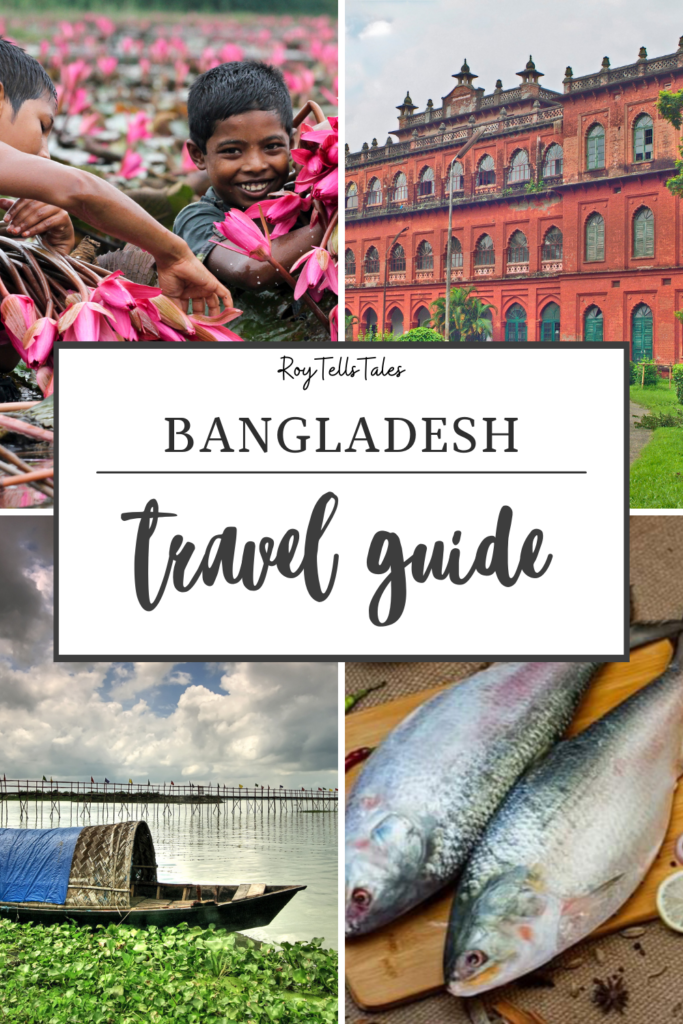
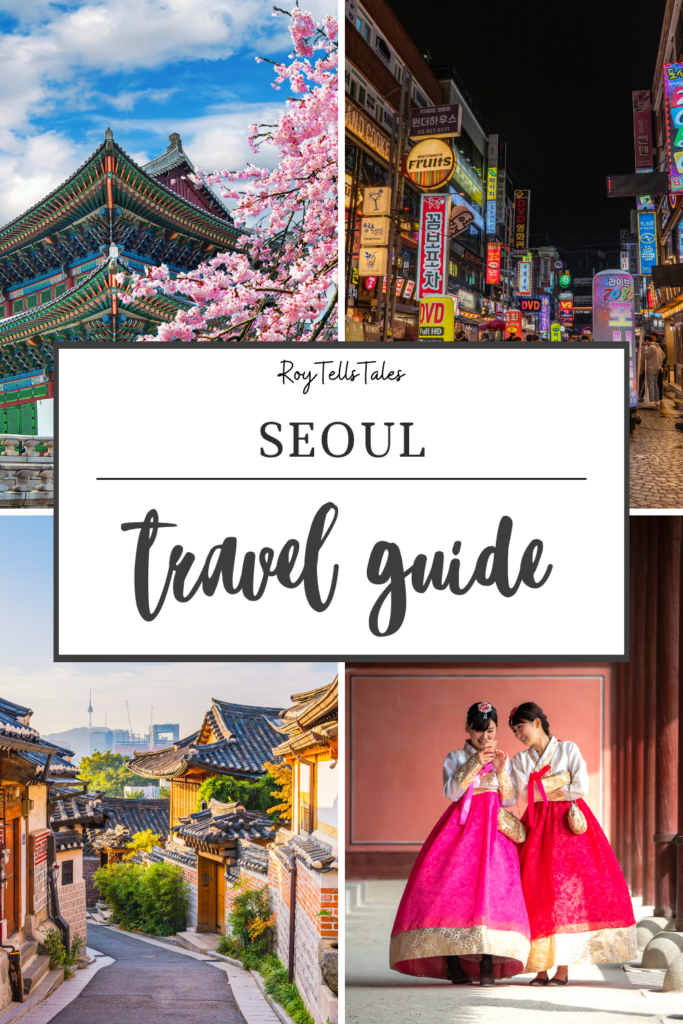








This is a great help as I plan my trip this December. One quick question on Indian passport traveller requesting for Egypt visa. I have booked and planned my travel on my own but while looking for evisa it is saying I can only get in with a guarantee letter and airport presence of a travel agency. is this true and what is a way around this !
Hey Samik, not really! They don’t ask for the travel agent’s letter, unless you have booked a package tour. At immigration, they’ll ask you.